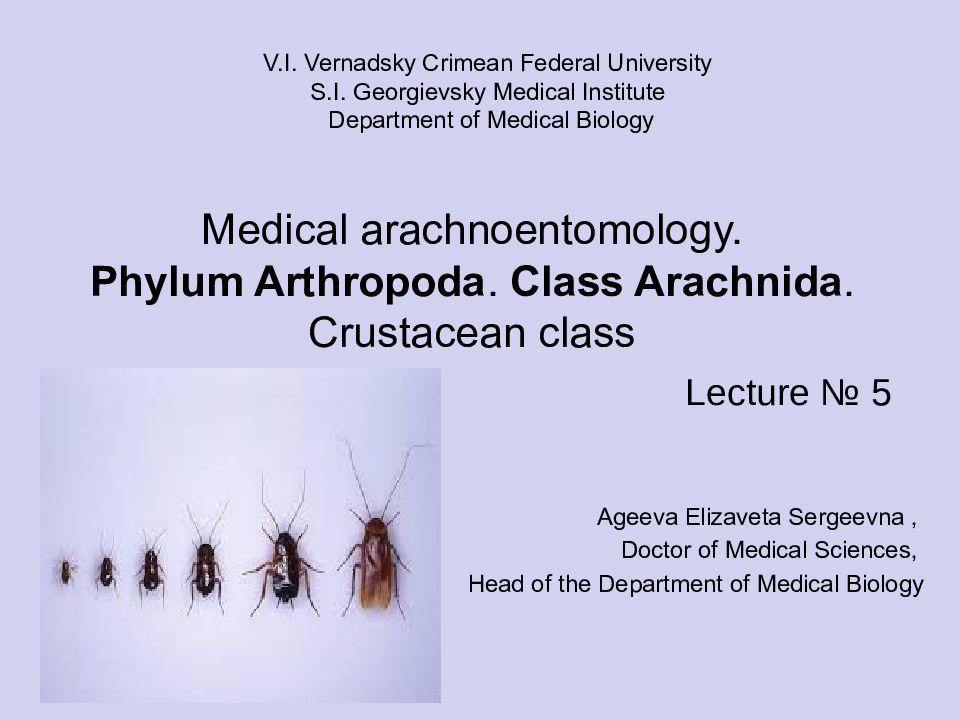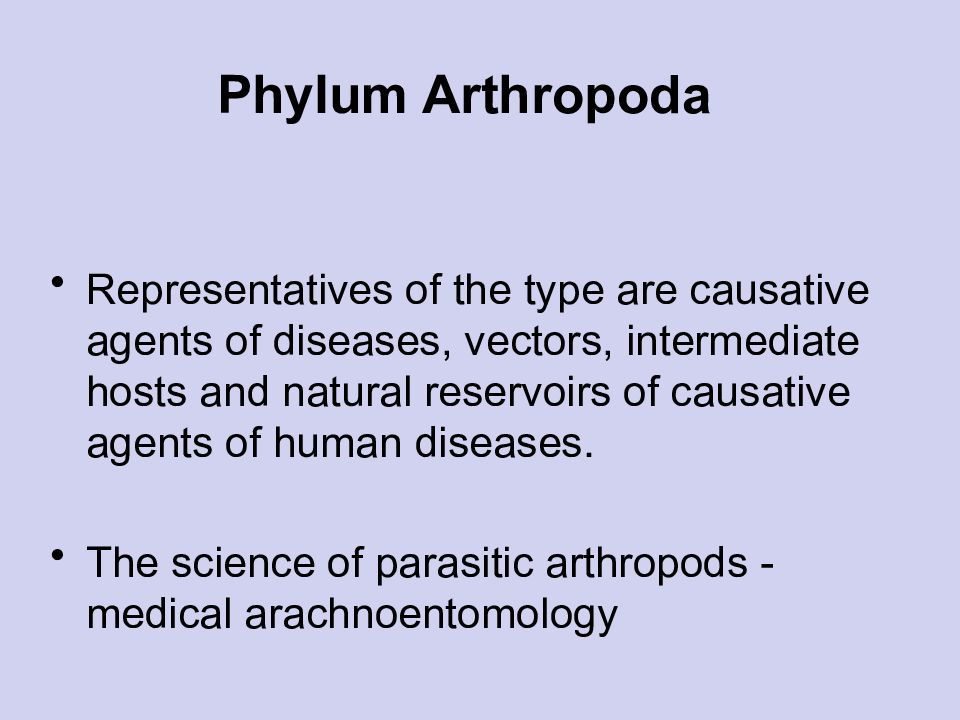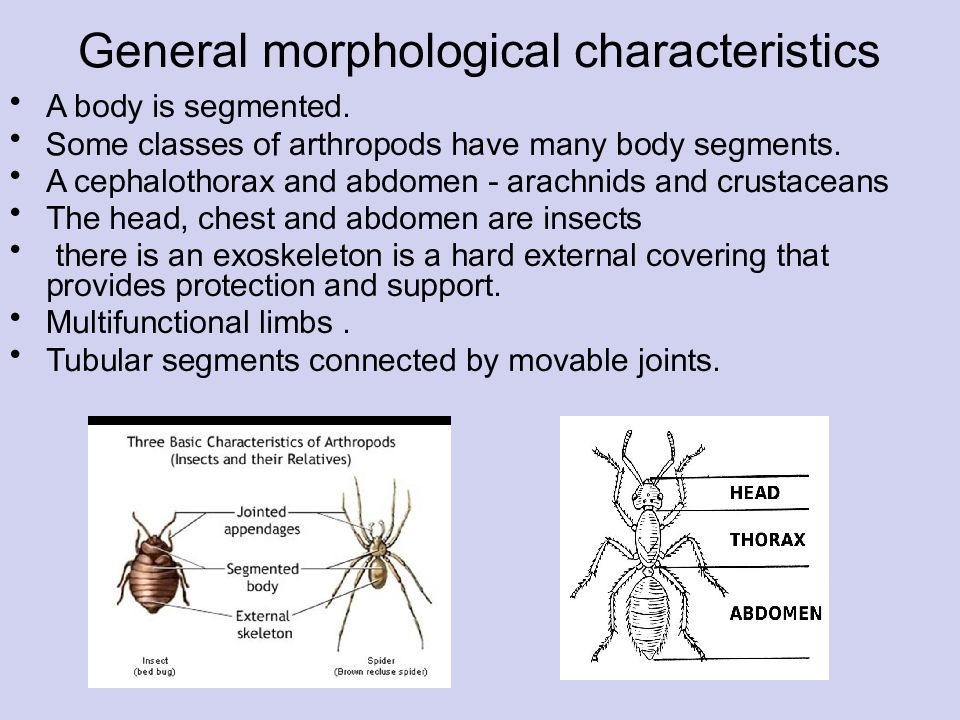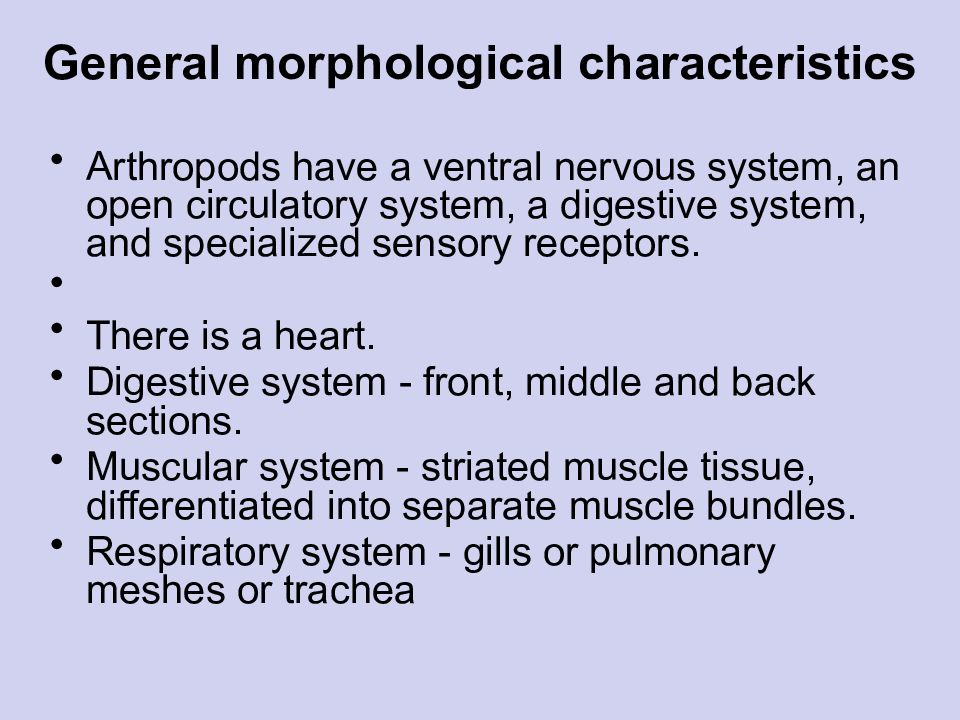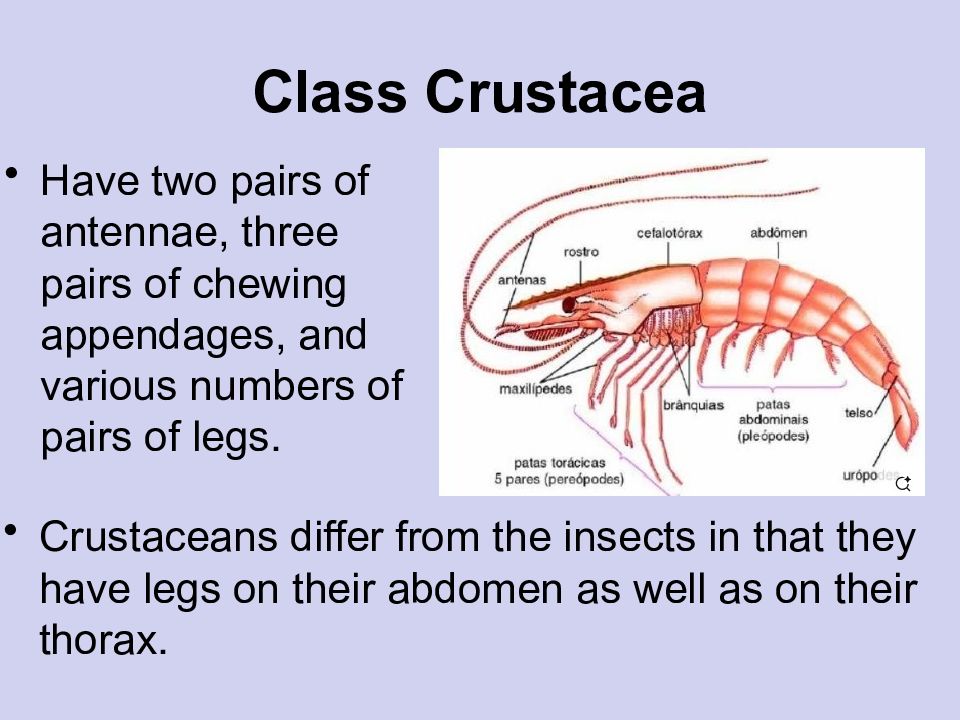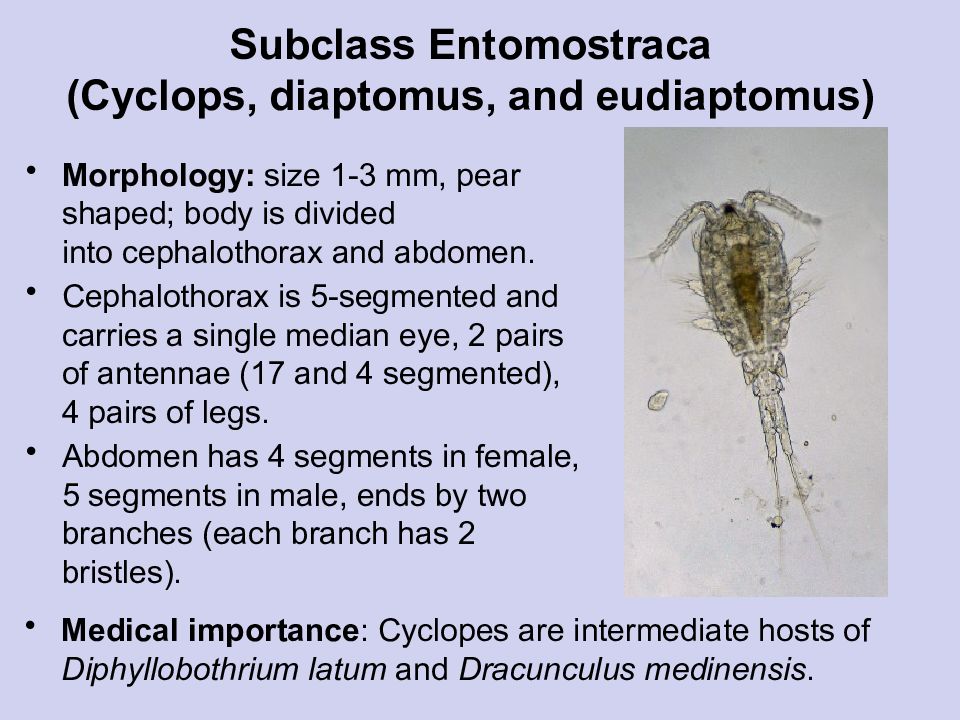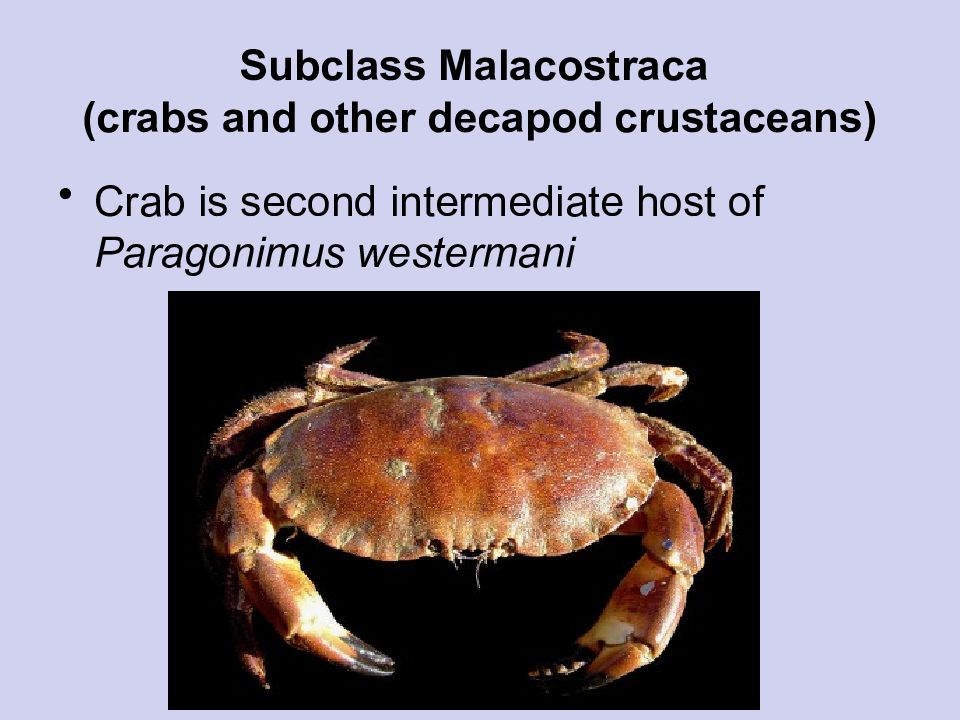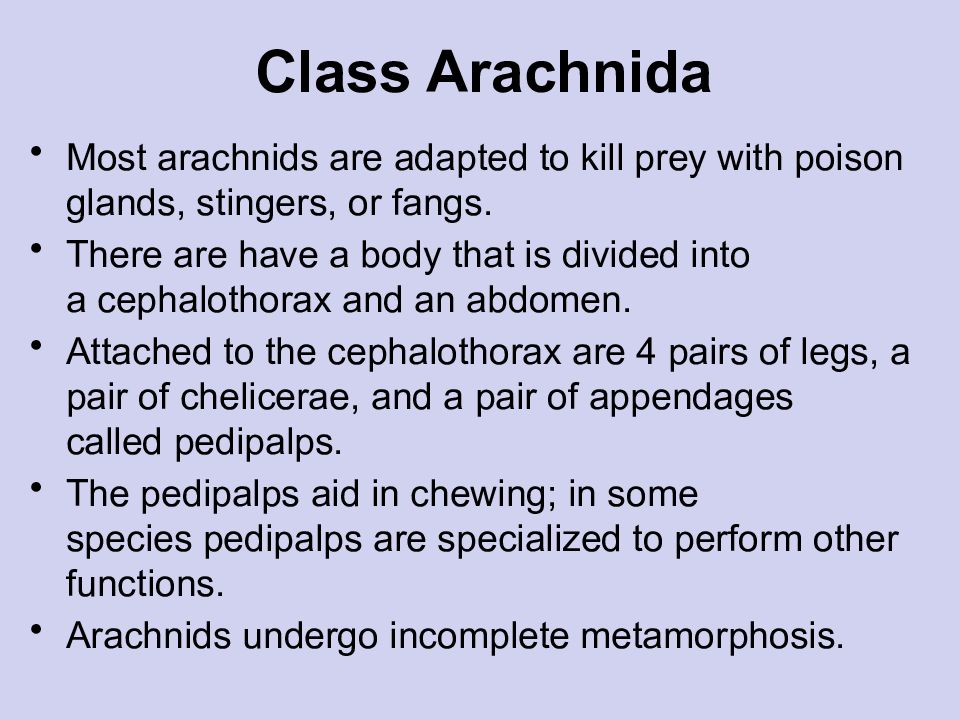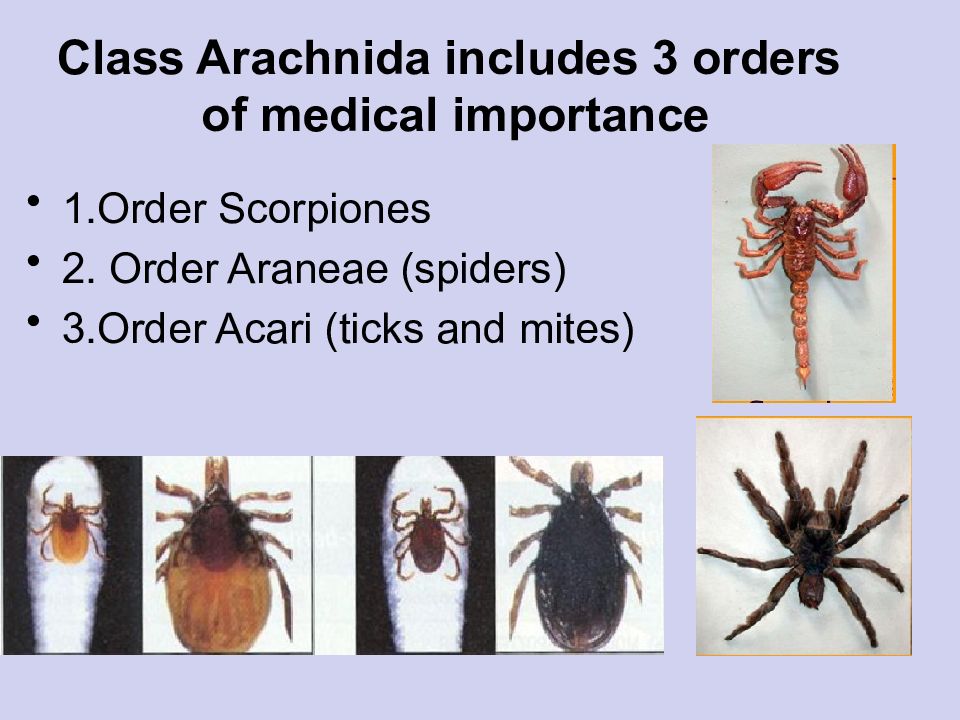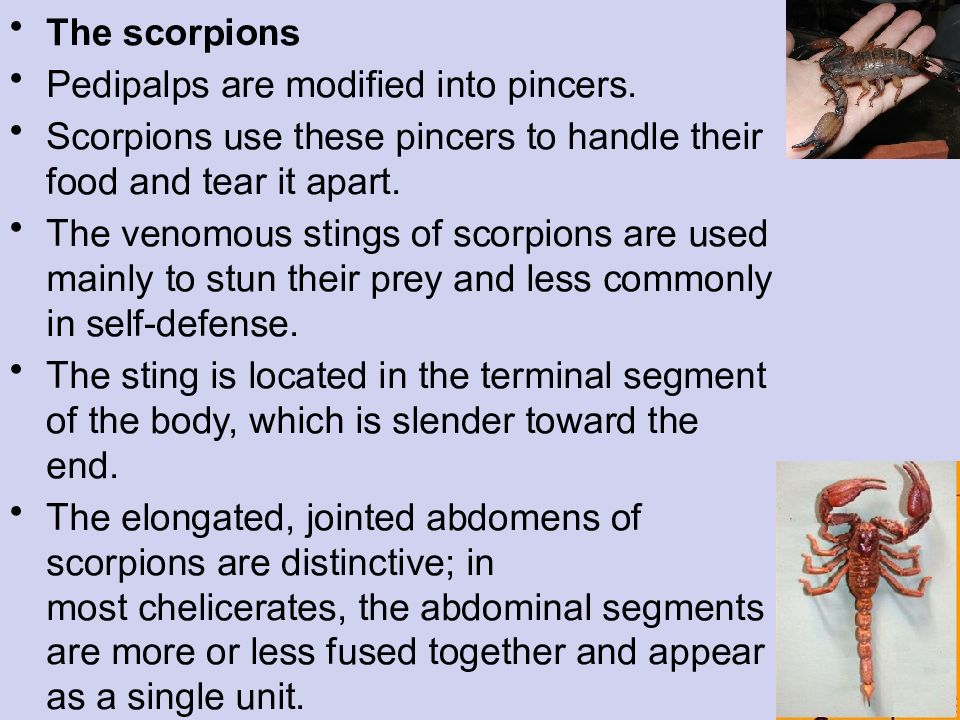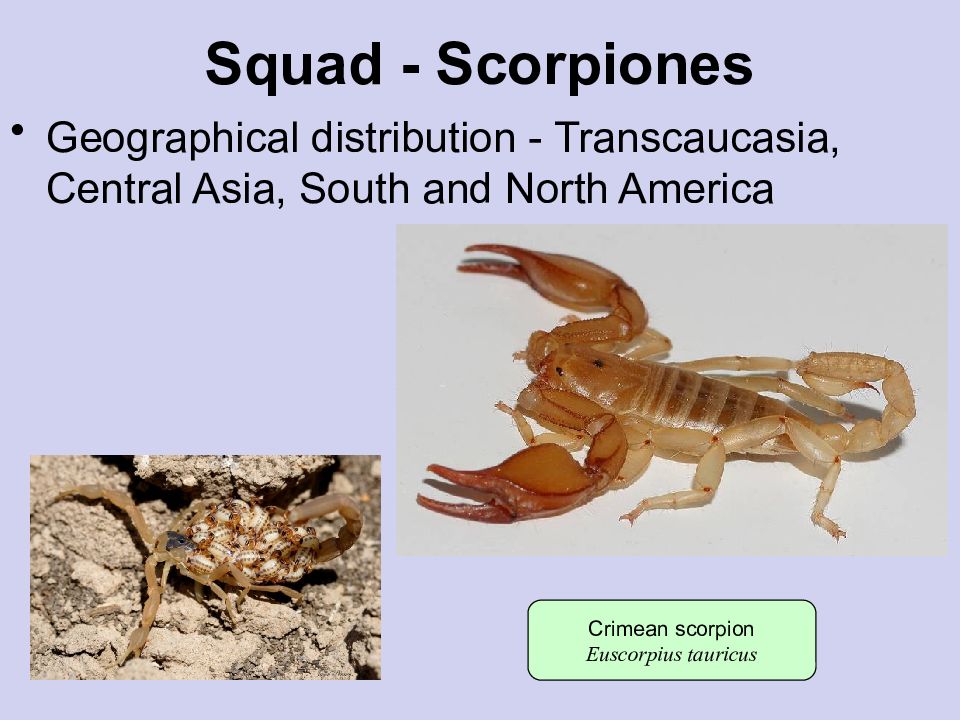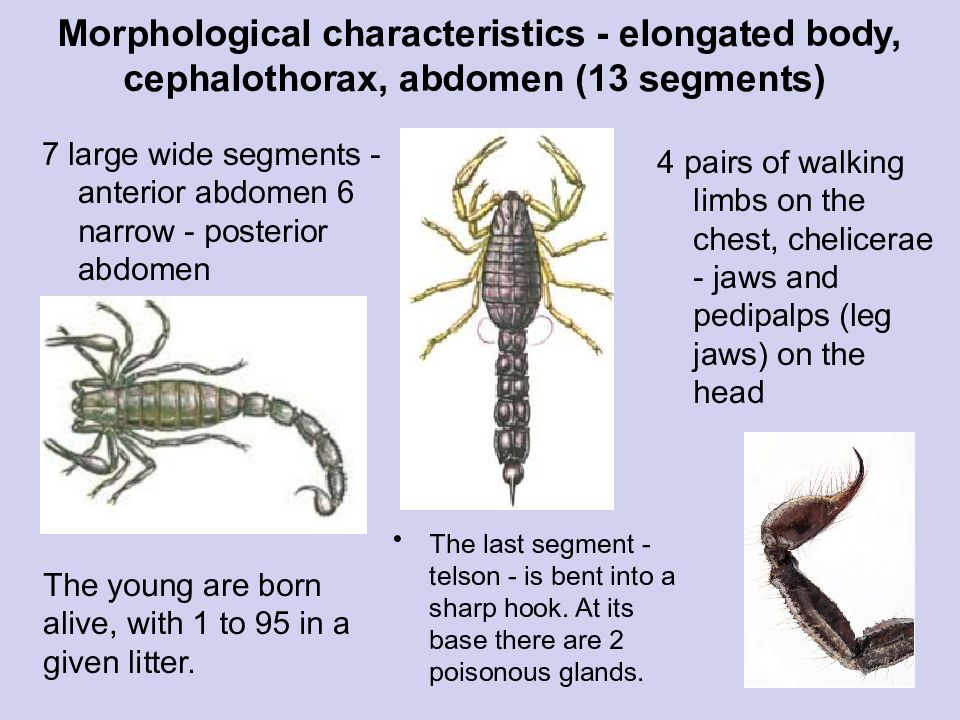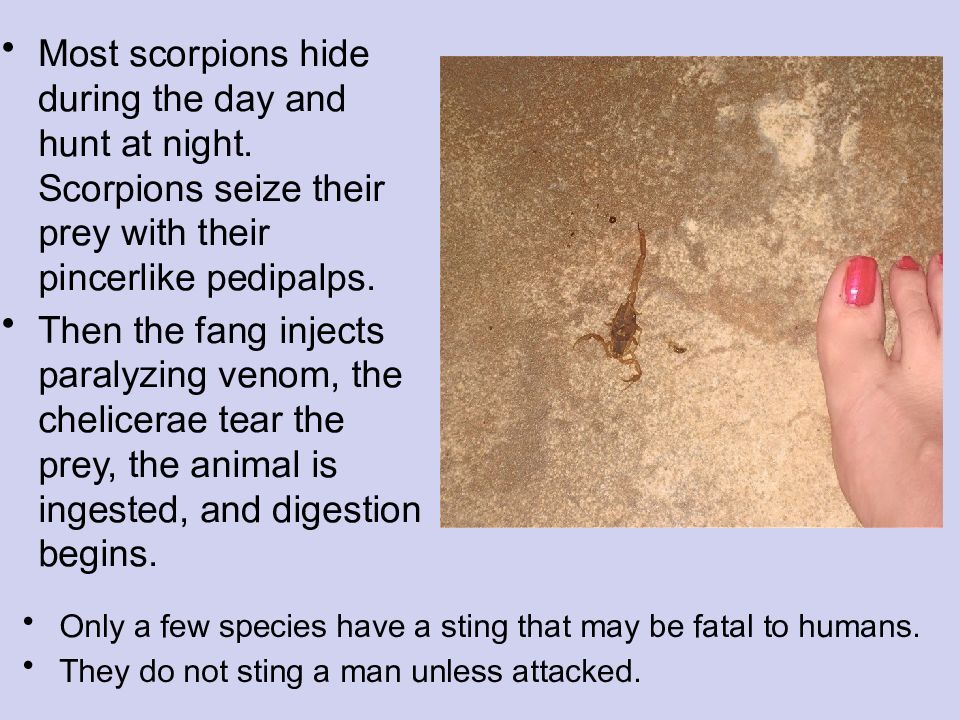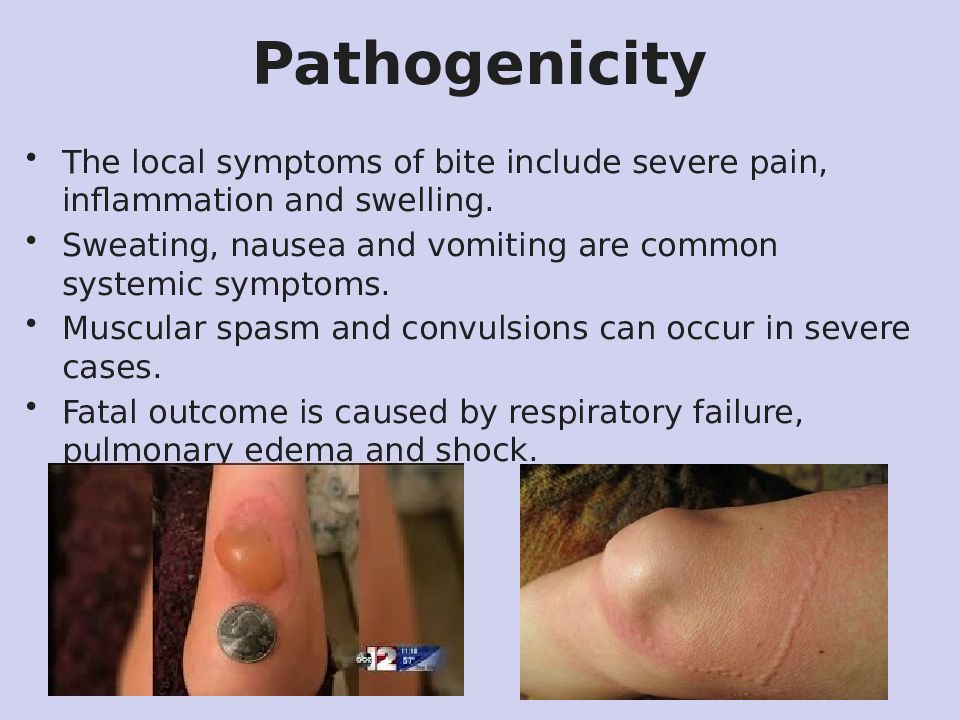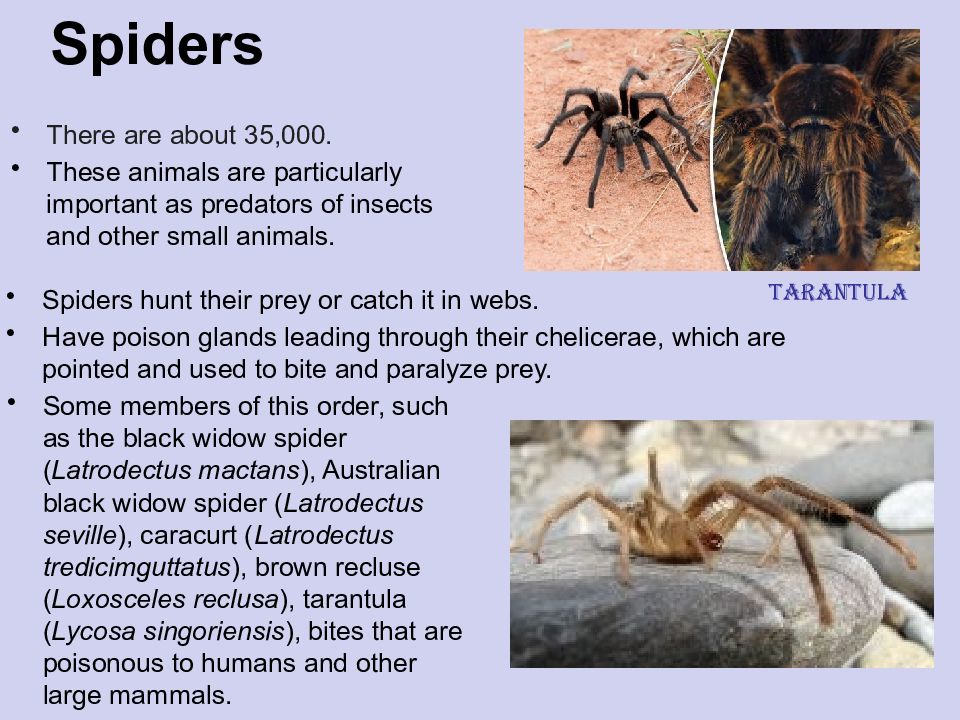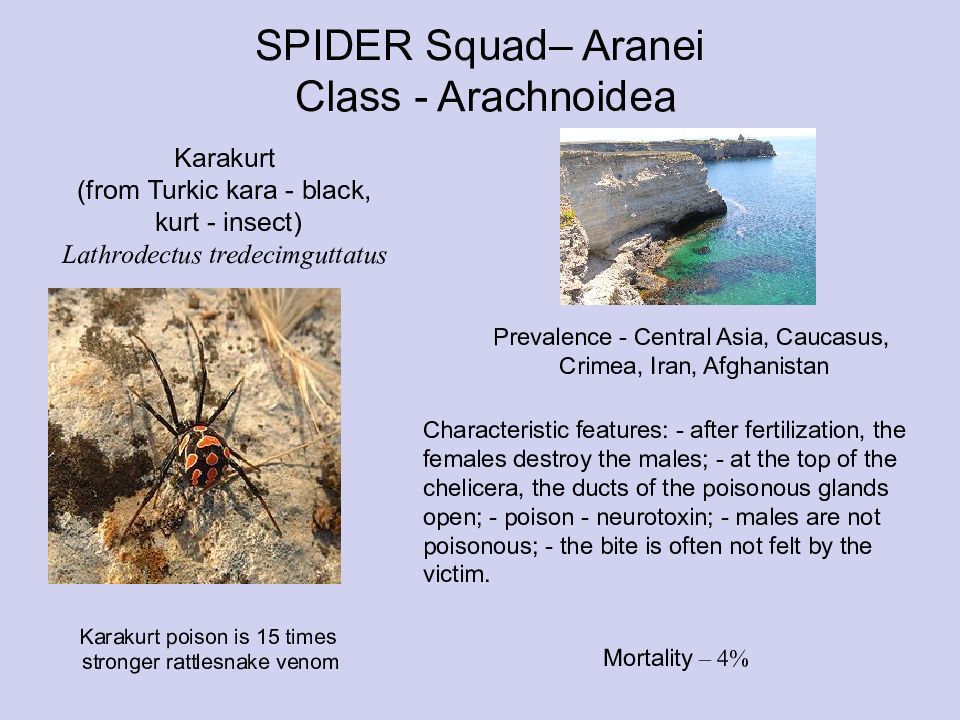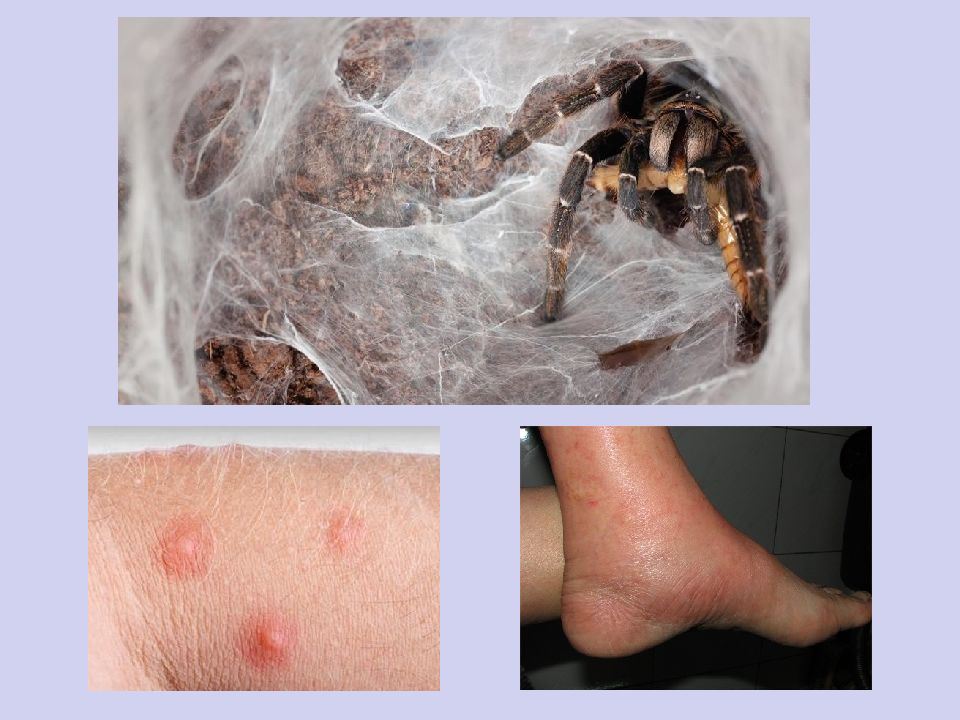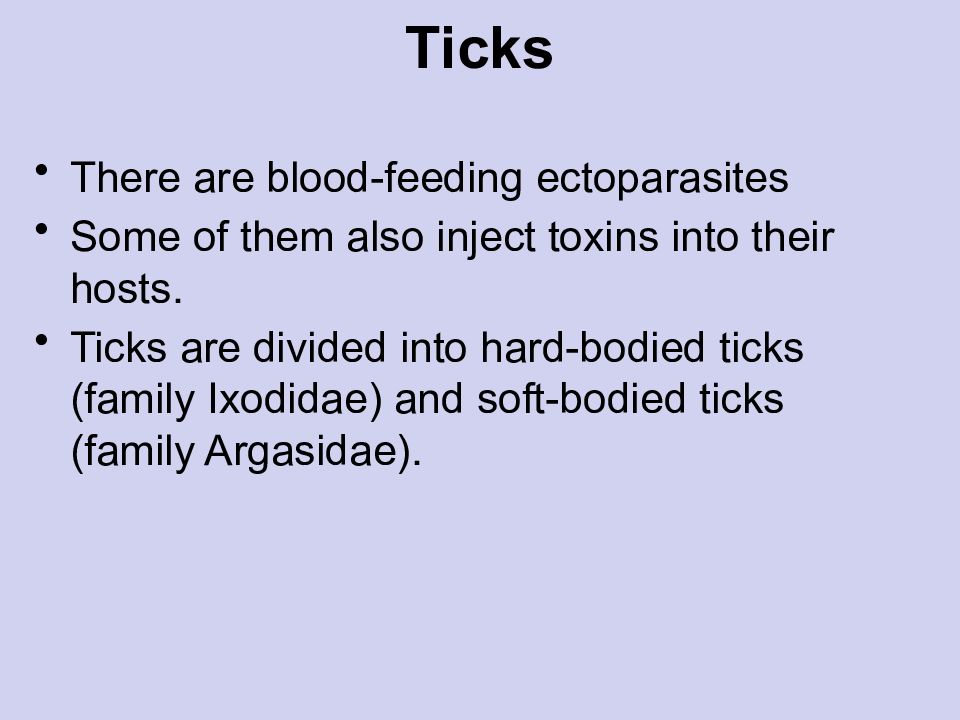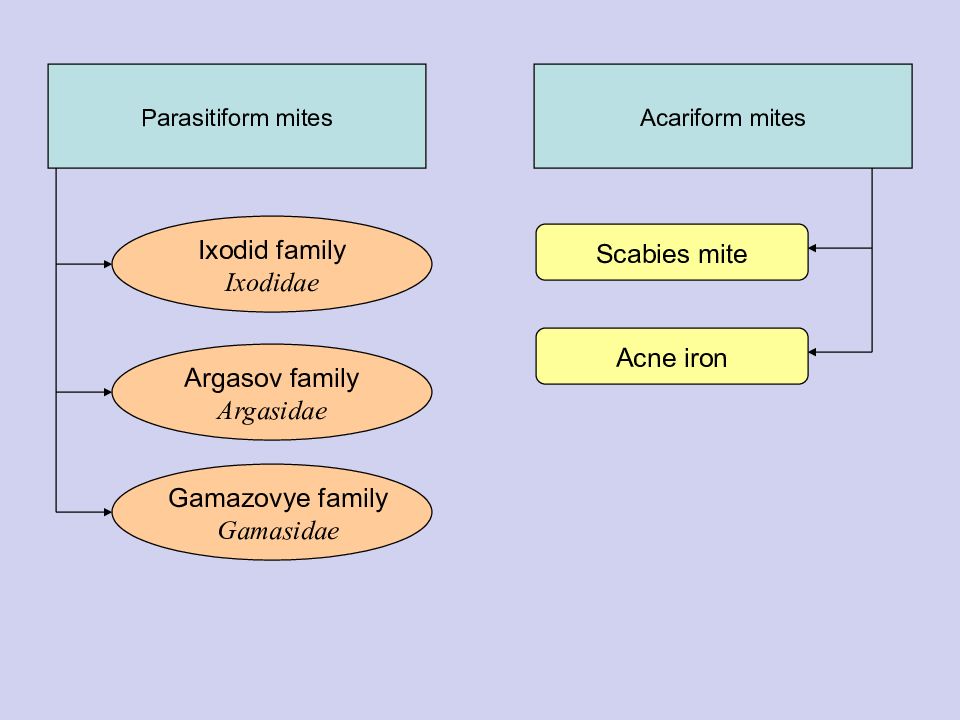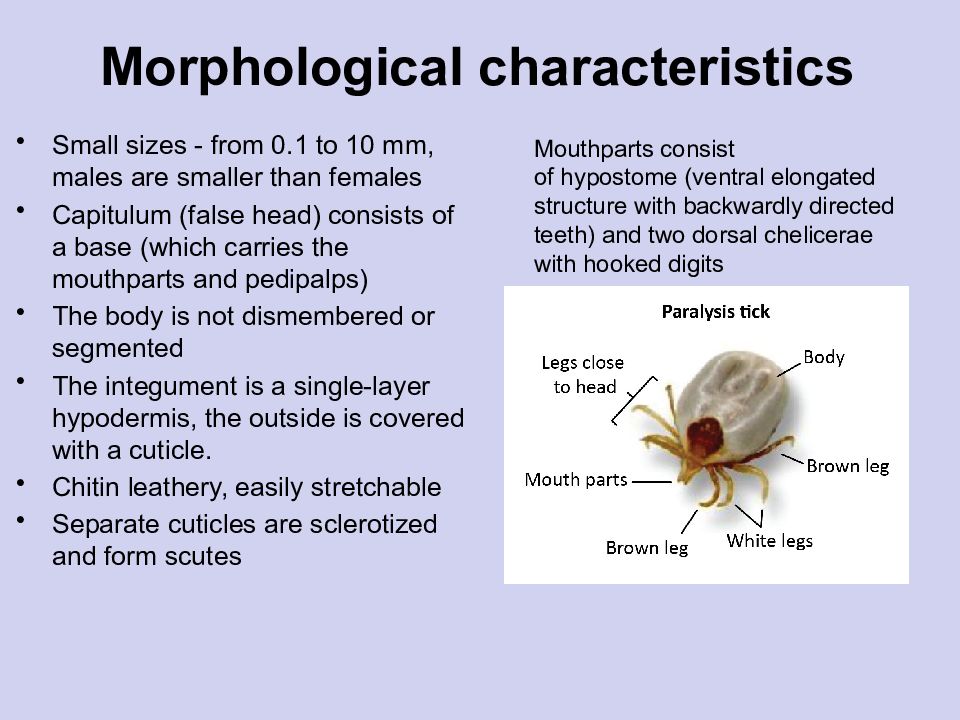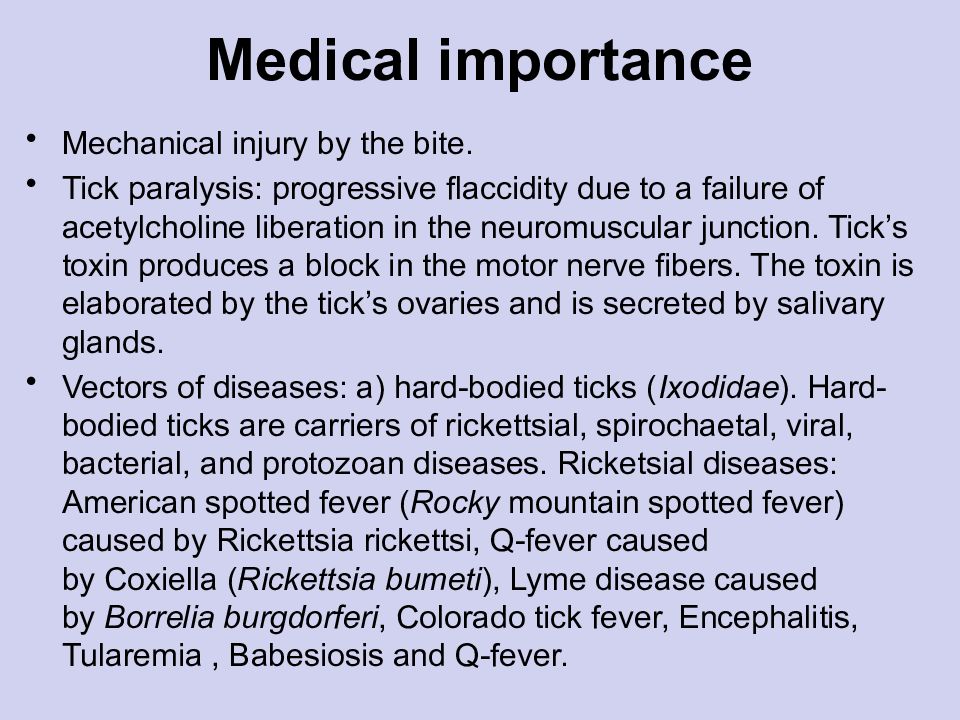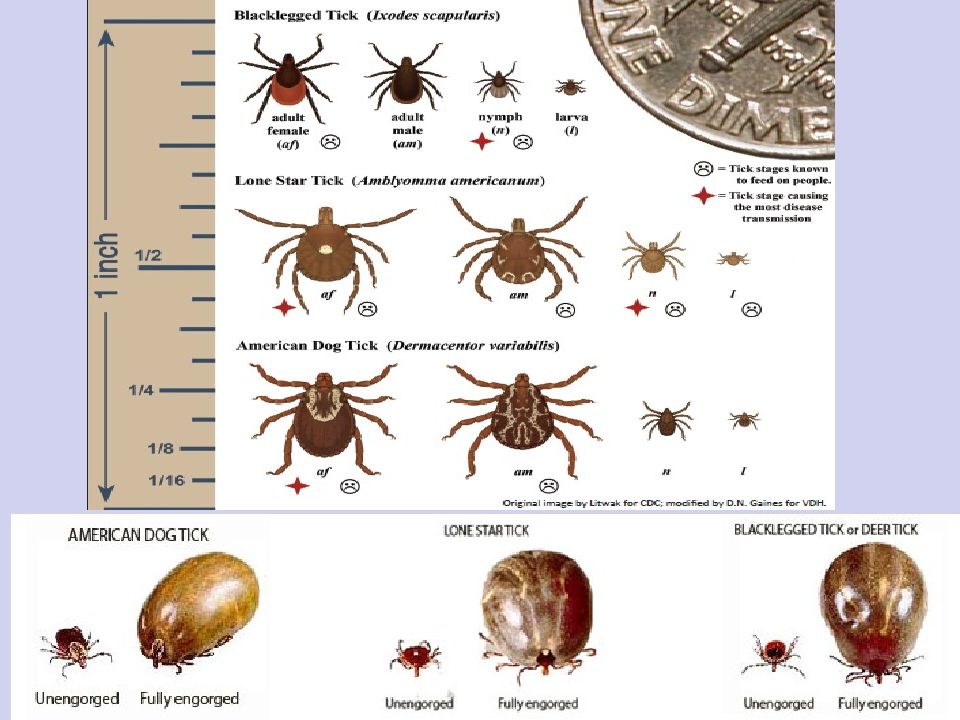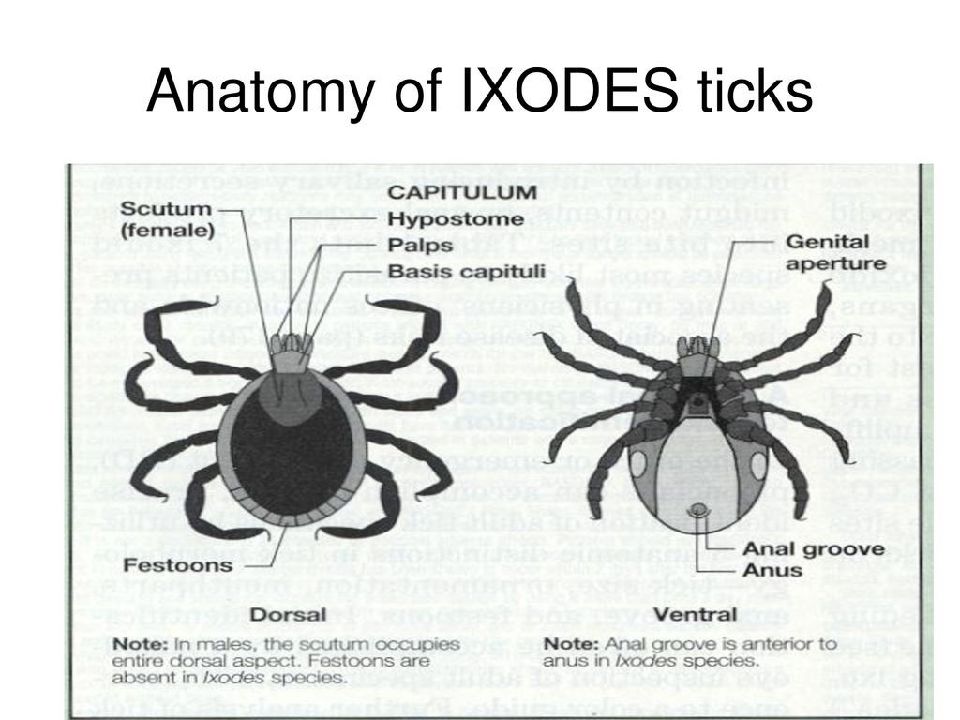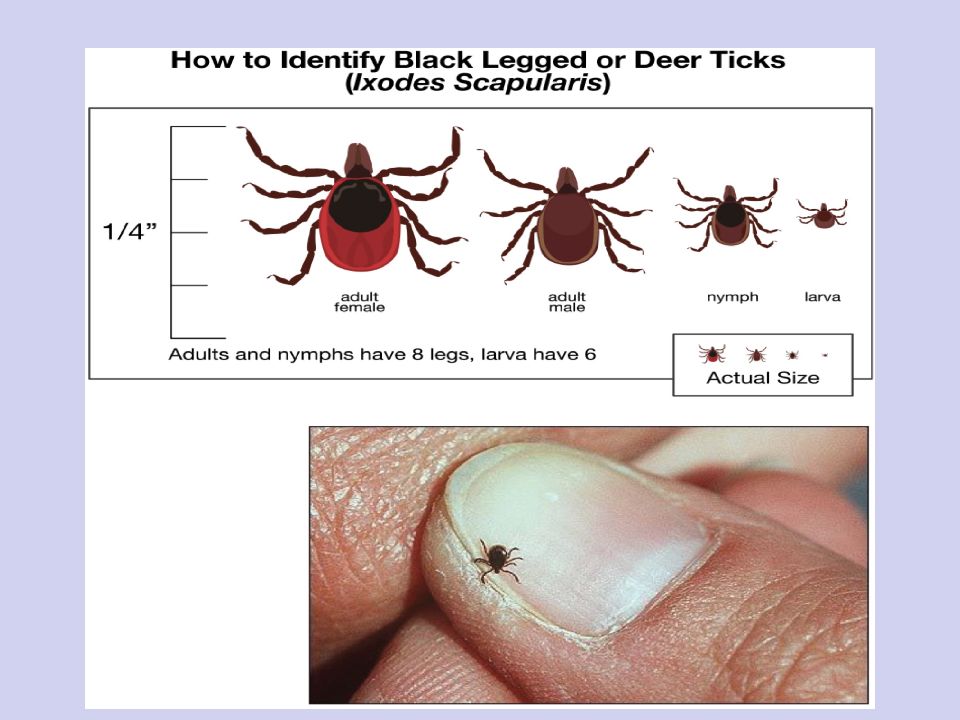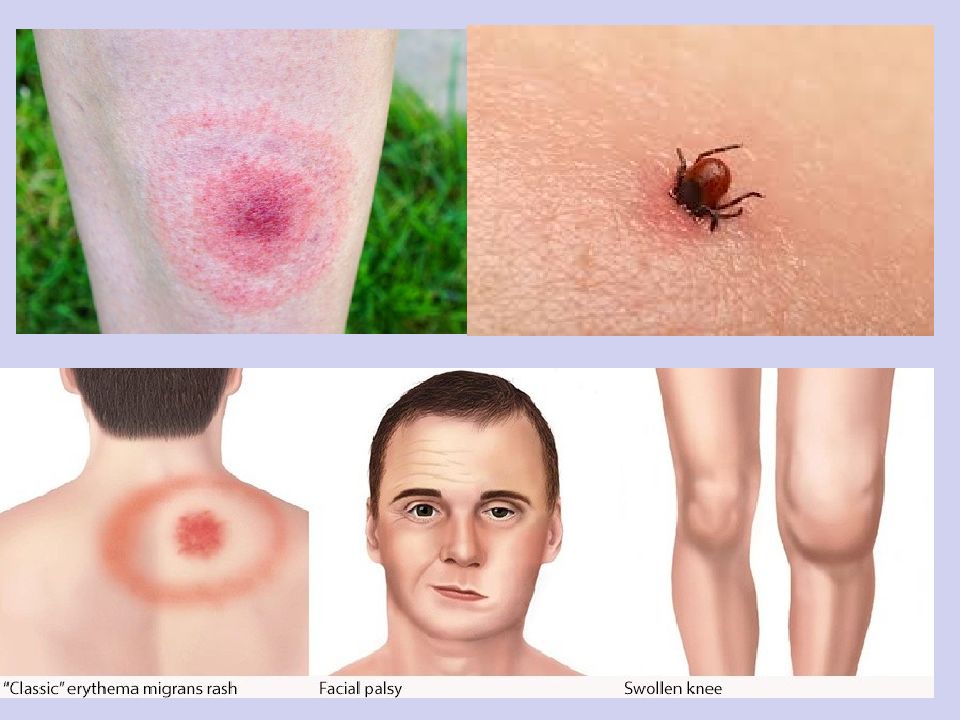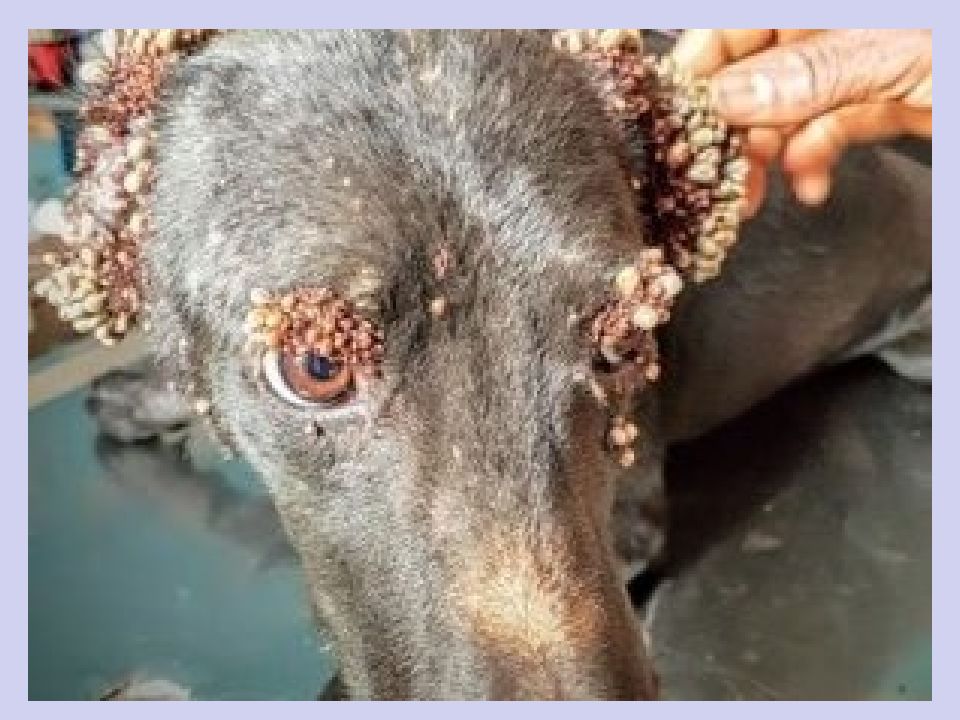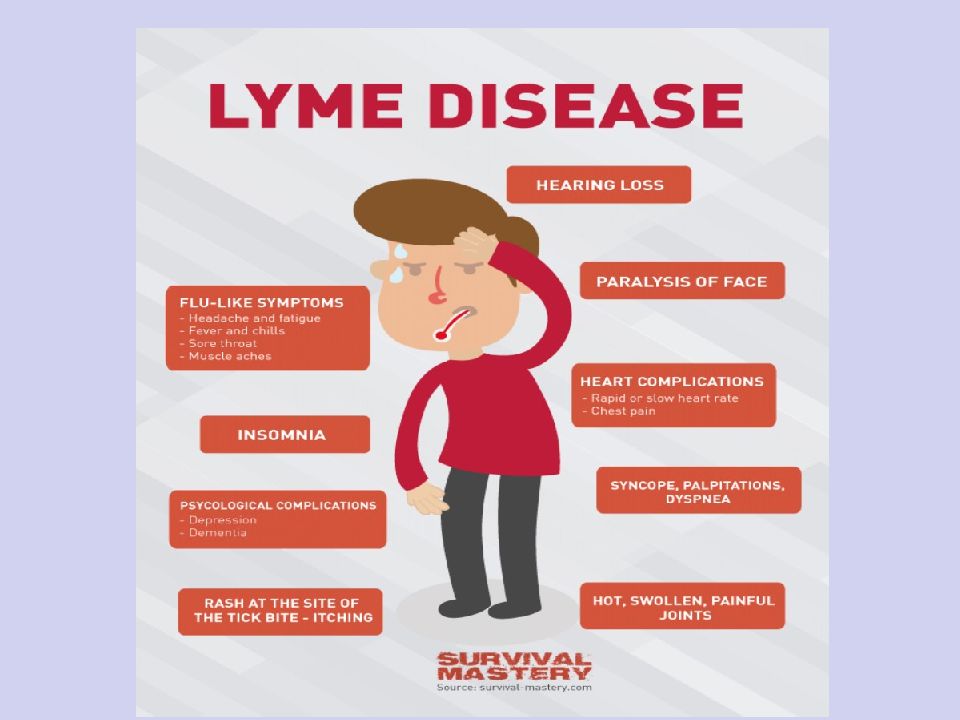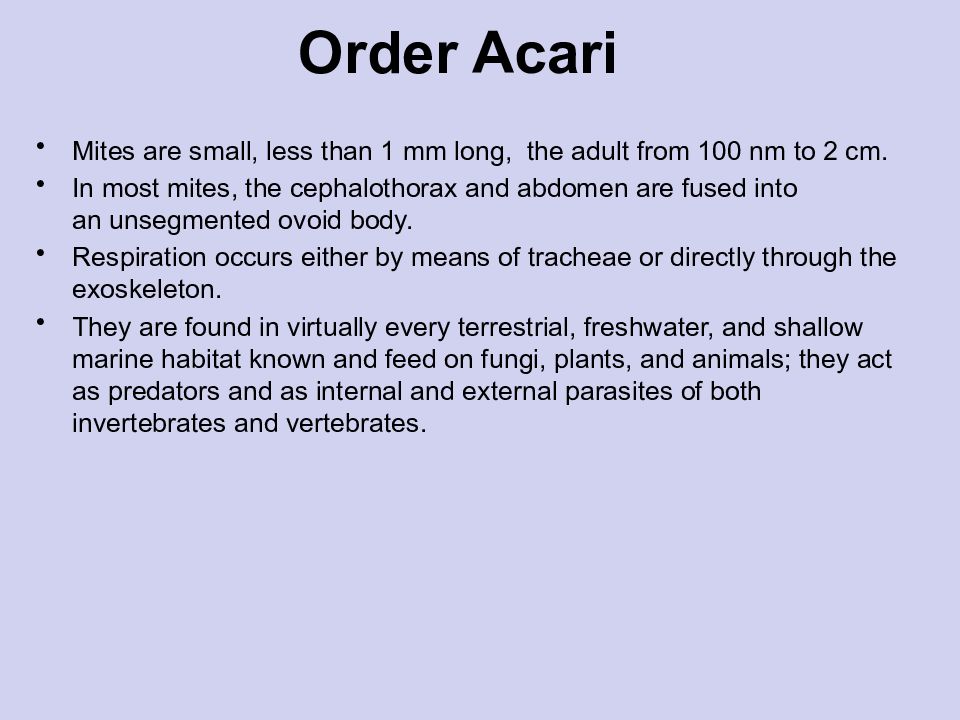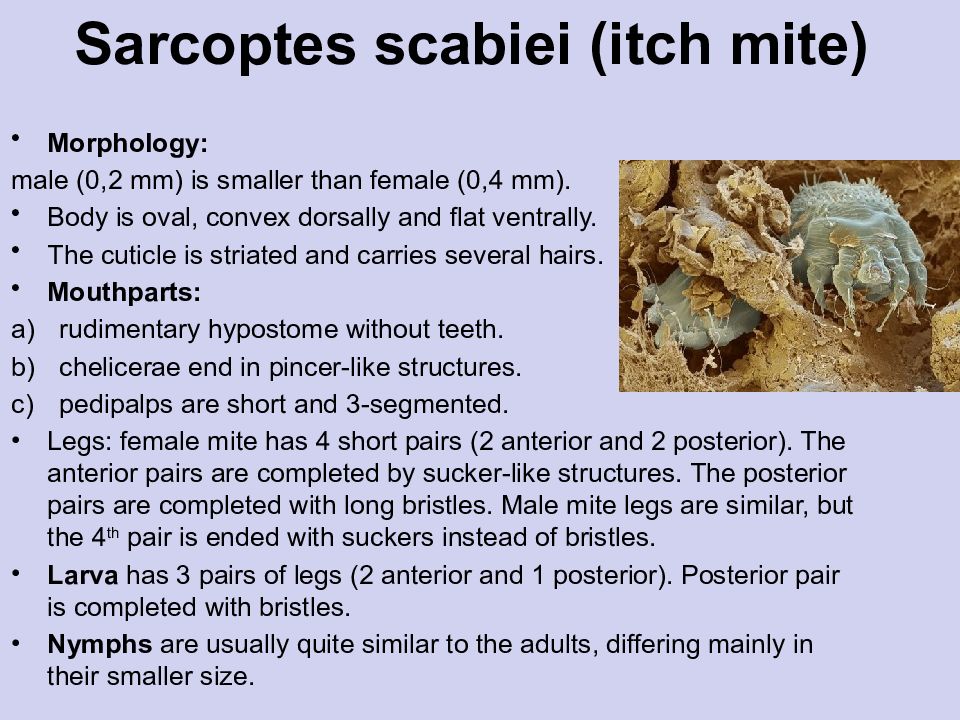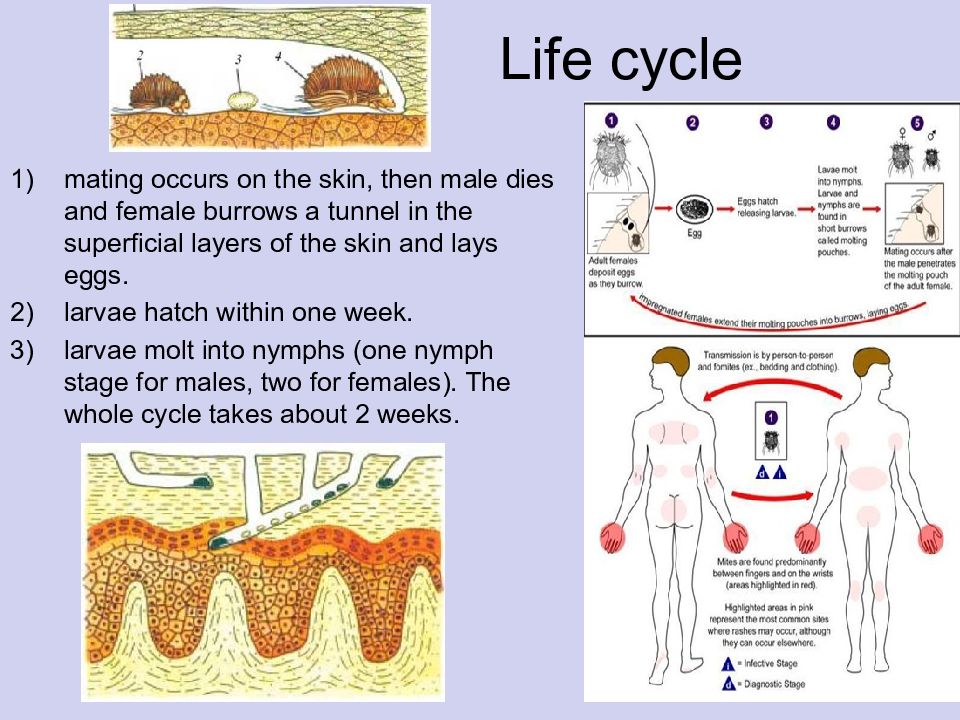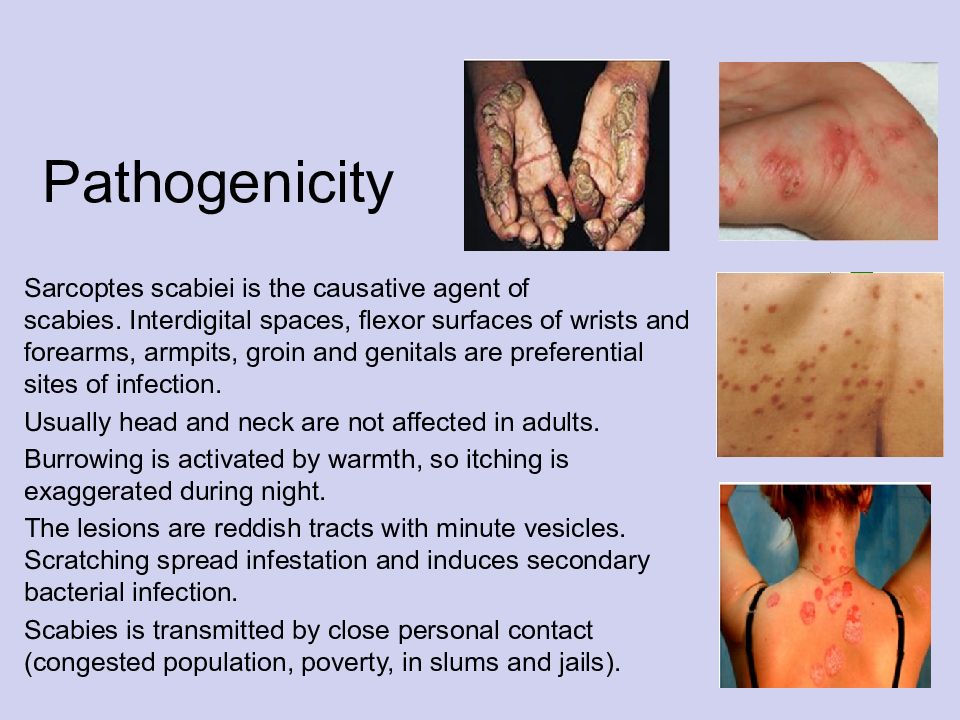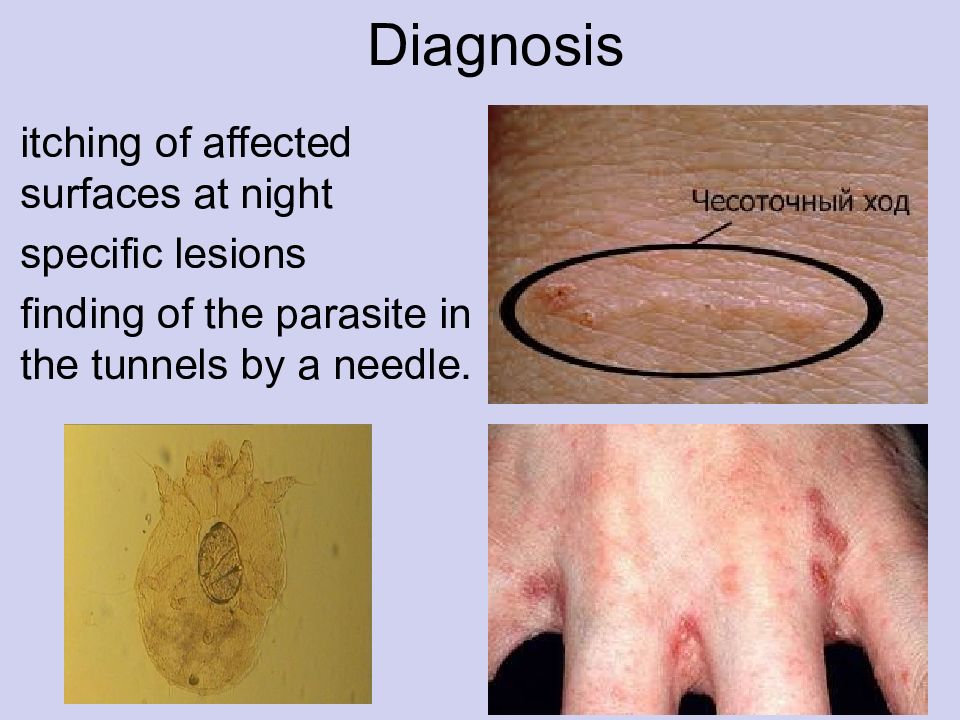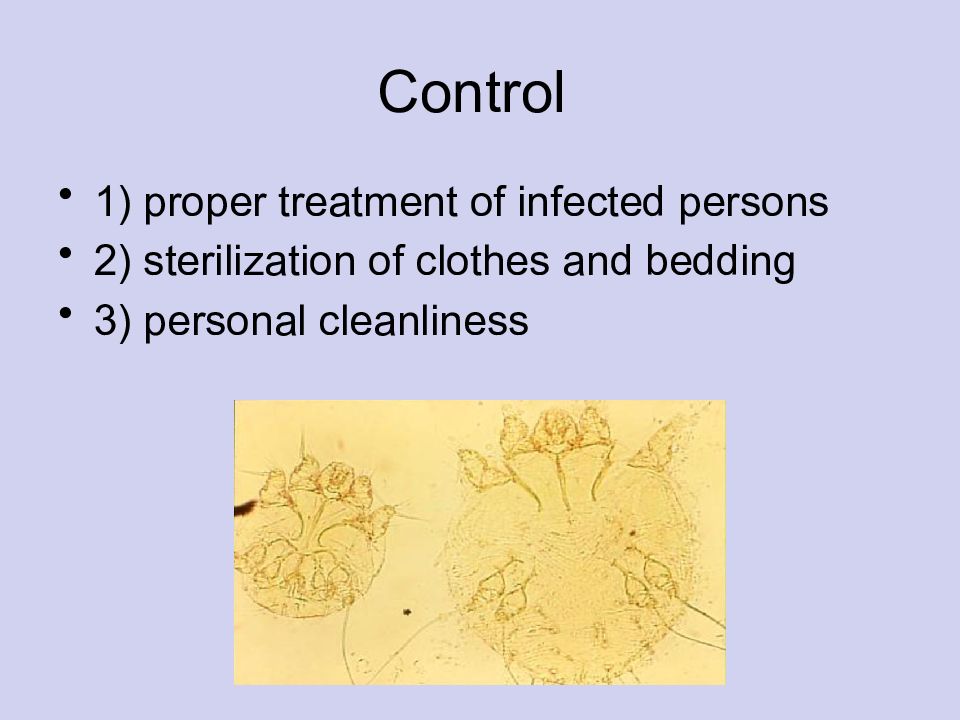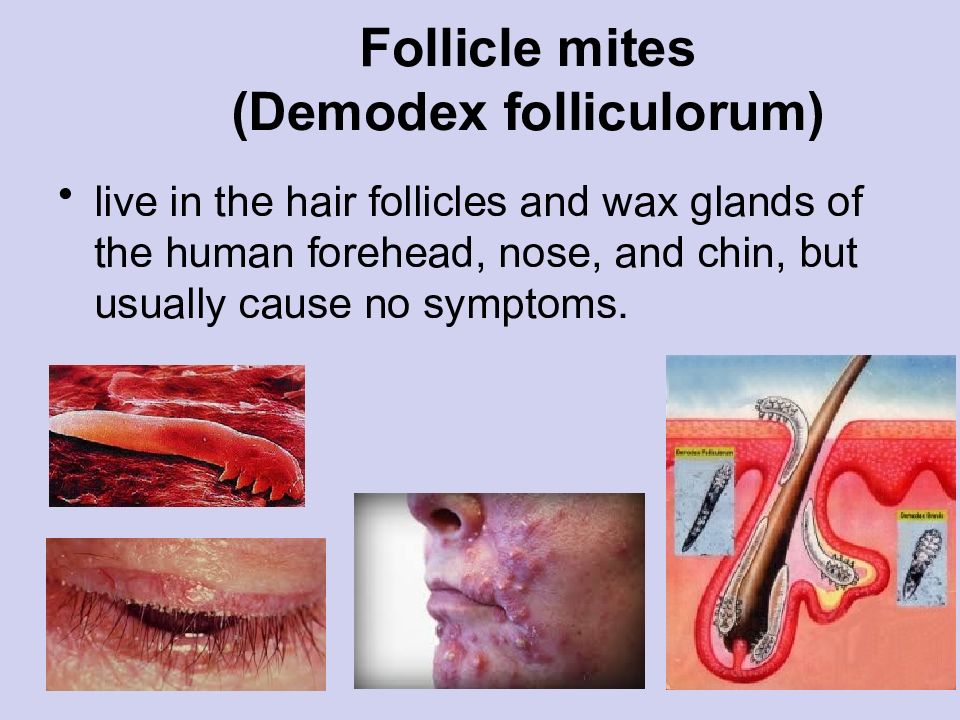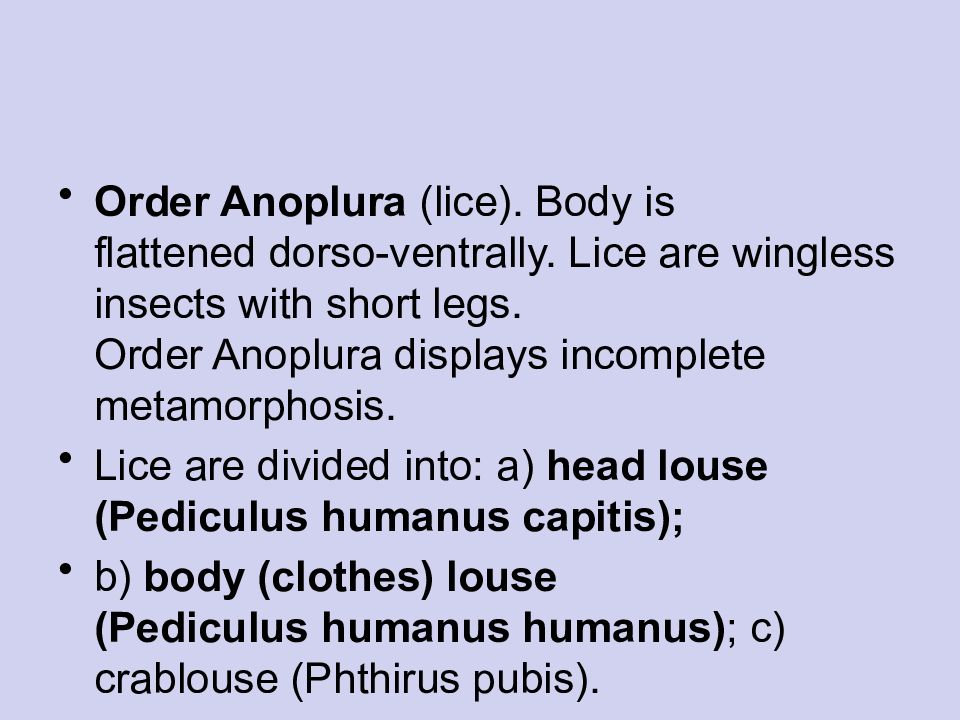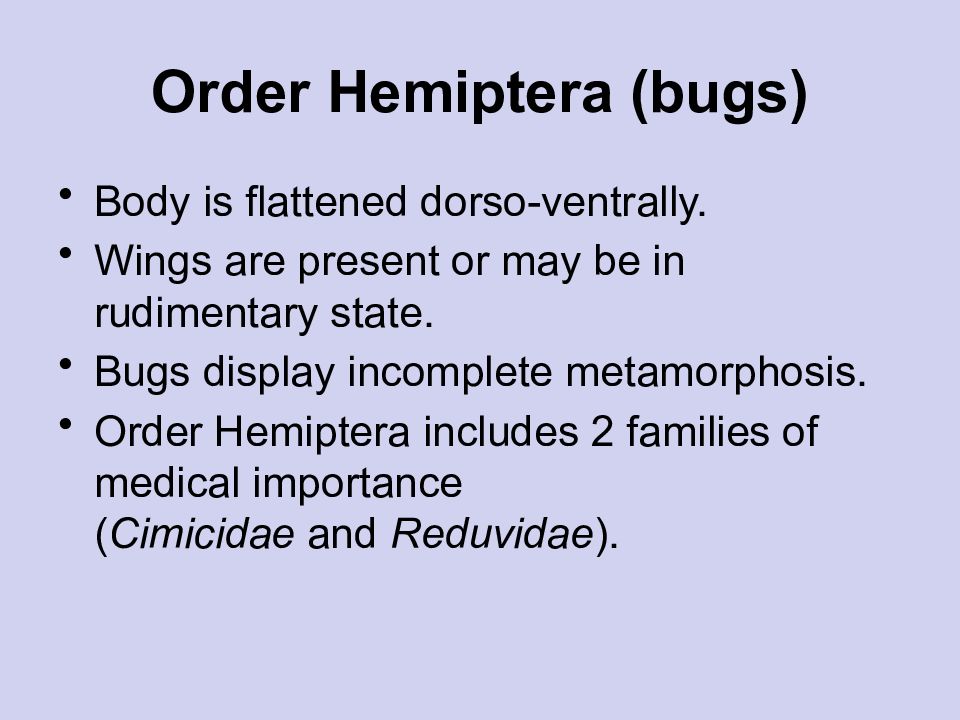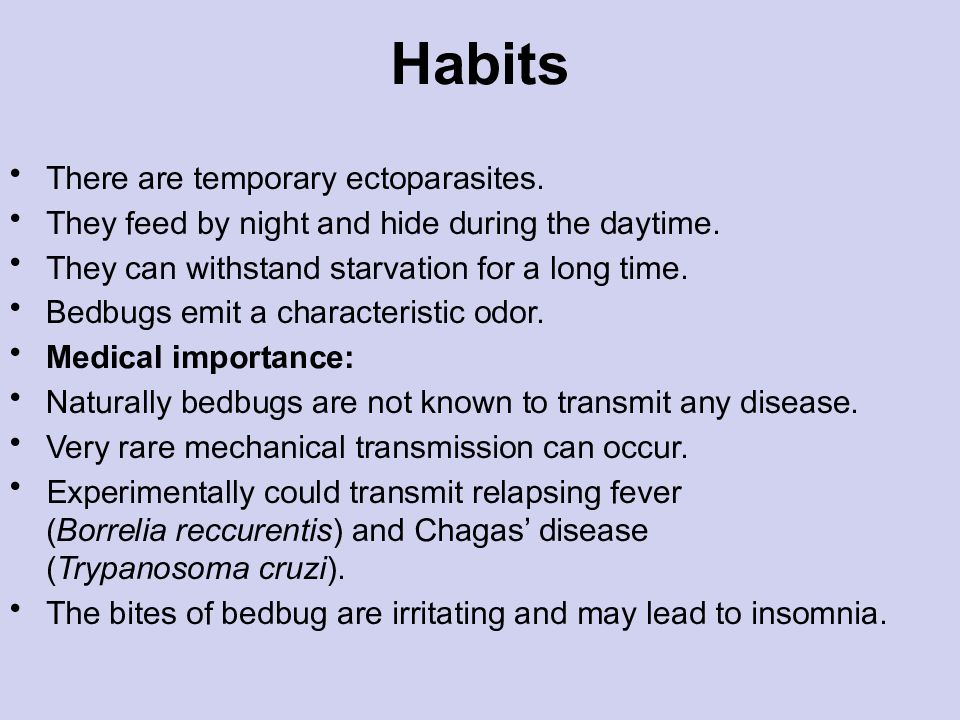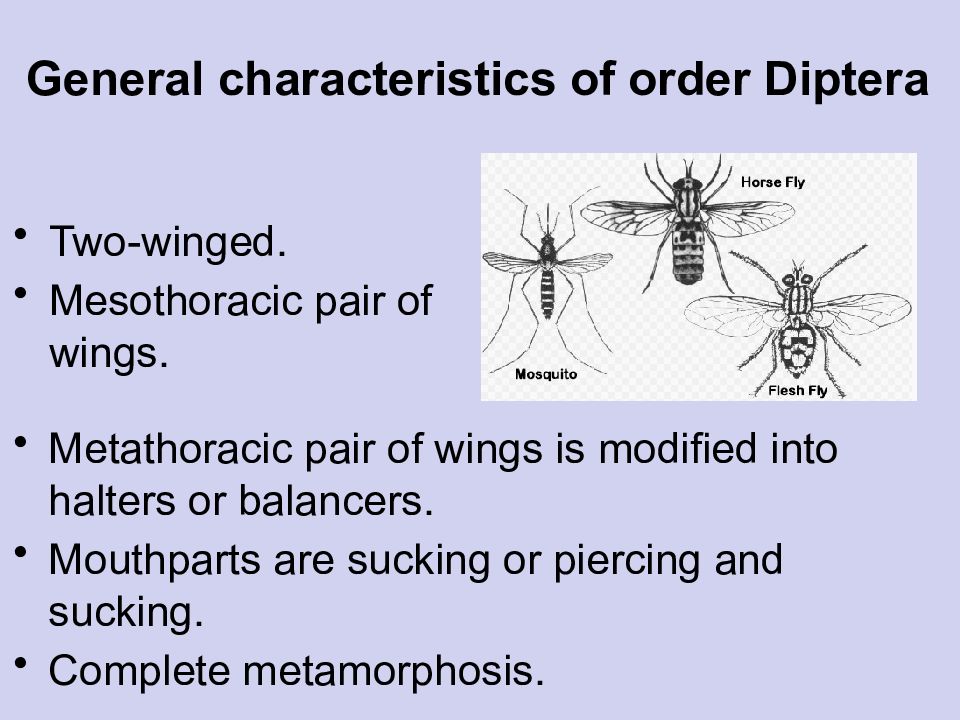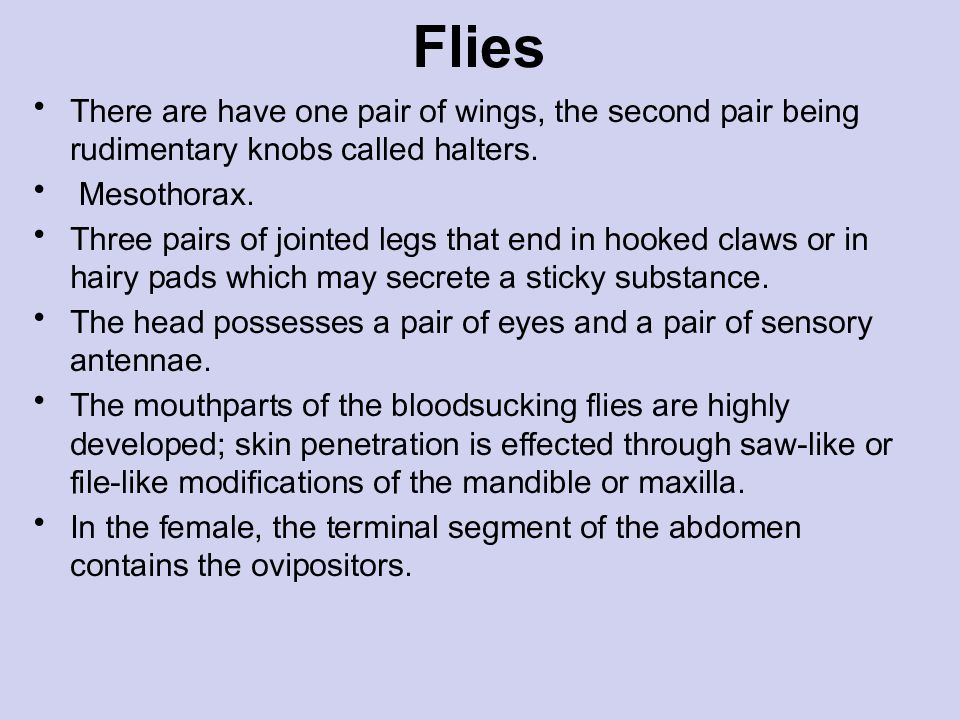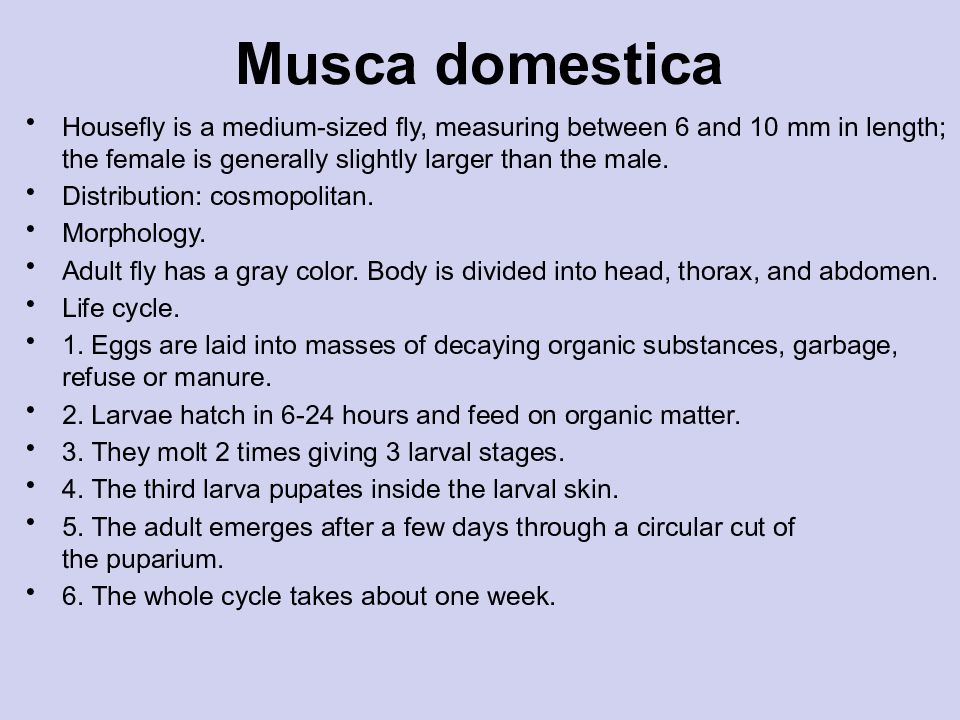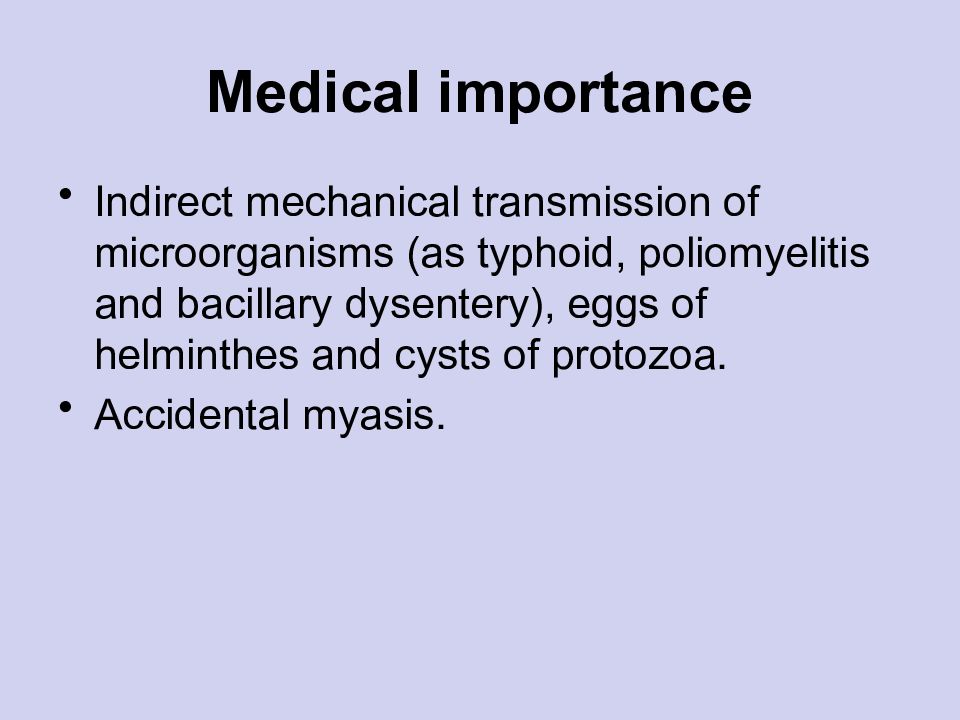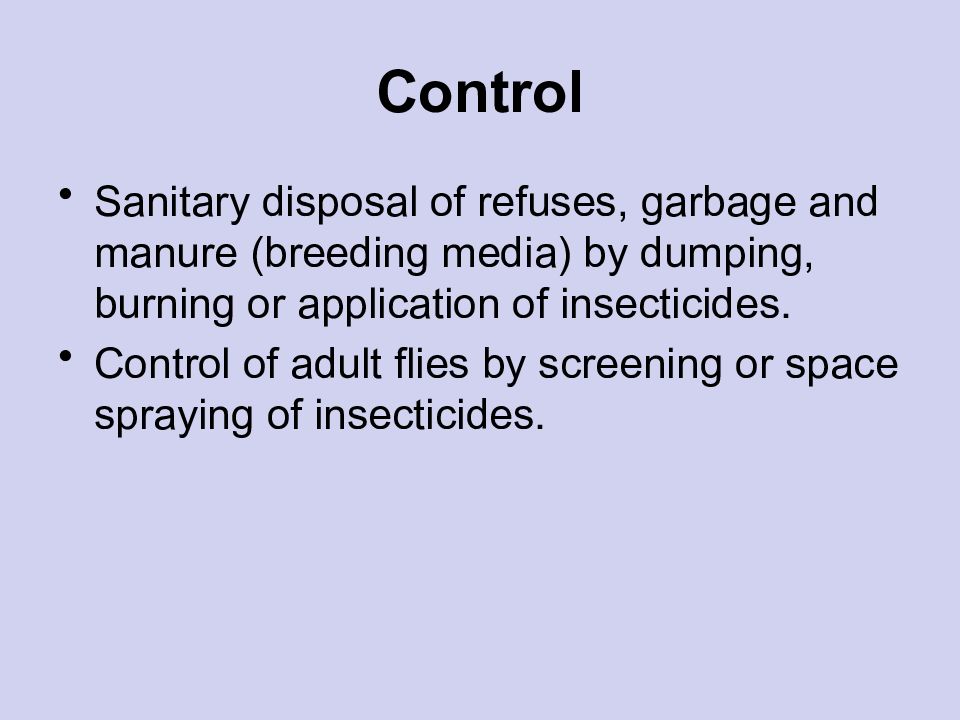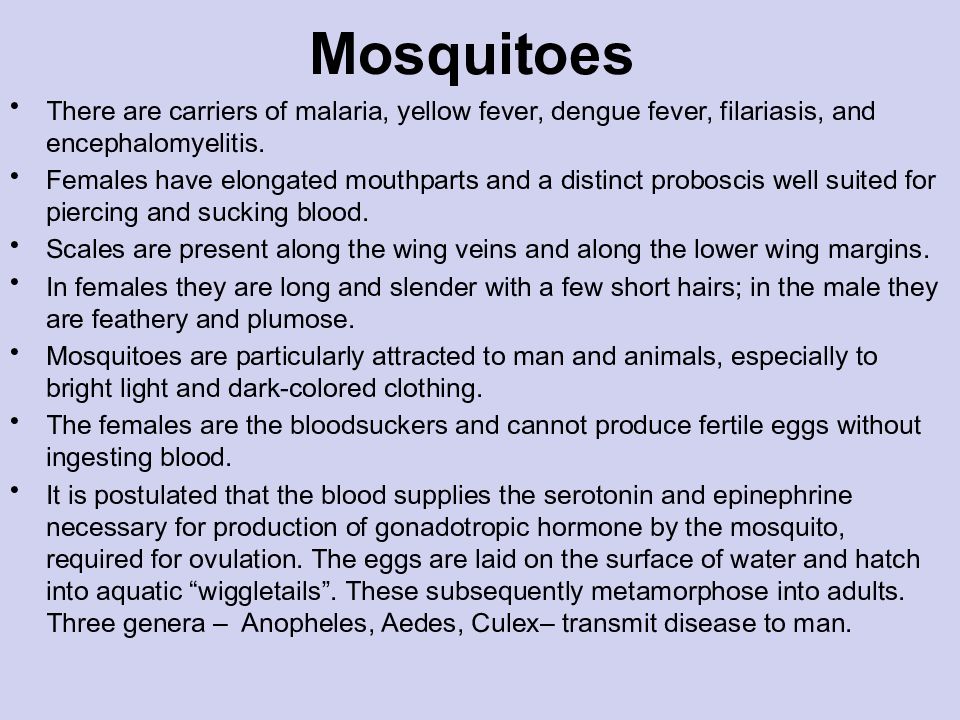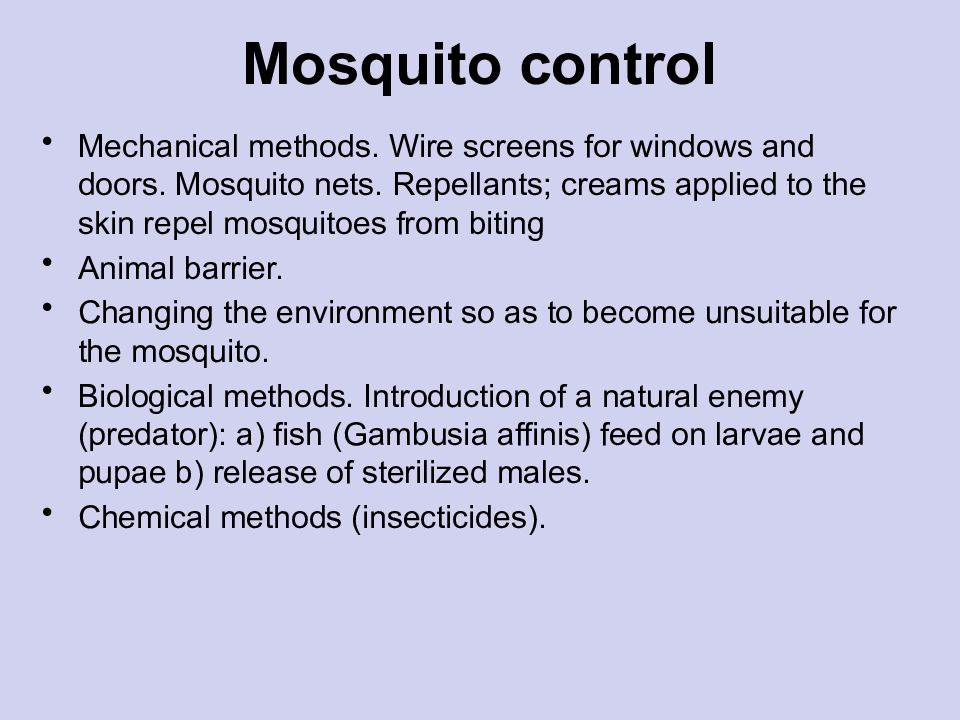Первый слайд презентации
Lecture № 5 V.I. Vernadsky Crimean Federal University S.I. Georgievsky Medical Institute Department of Medical Biology Ageeva Elizaveta Sergeevna, Doctor of Medical Sciences, Head of the Department of Medical Biology Medical arachnoentomology. Phylum Arthropoda. Class Arachnida. Crustacean class
Слайд 2: Phylum Arthropoda
Representatives of the type are causative agents of diseases, vectors, intermediate hosts and natural reservoirs of causative agents of human diseases. The science of parasitic arthropods - medical arachnoentomology
Слайд 3: General morphological characteristics
A body is segmented. Some classes of arthropods have many body segments. A cephalothorax and abdomen - arachnids and crustaceans The head, chest and abdomen are insects there is an exoskeleton is a hard external covering that provides protection and support. Multifunctional limbs. Tubular segments connected by movable joints.
Слайд 4: General morphological characteristics
Arthropods have a ventral nervous system, an open circulatory system, a digestive system, and specialized sensory receptors. There is a heart. Digestive system - front, middle and back sections. Muscular system - striated muscle tissue, differentiated into separate muscle bundles. Respiratory system - gills or pulmonary meshes or trachea
Слайд 5: Phylum Arthropoda
Includes 3 classes which has medical importance: 1. Class Crustacea – Cyclops, crabs 2. Class Arachnida (Octapoda) – scorpions, spiders, ticks and mites 3. Class Insecta (Hexapoda) - mosquitoes, fleas, lice, fleas, bugs
Слайд 6: Class Crustacea
Have two pairs of antennae, three pairs of chewing appendages, and various numbers of pairs of legs. Crustaceans differ from the insects in that they have legs on their abdomen as well as on their thorax.
Слайд 7: Subclass Entomostraca (Cyclops, diaptomus, and eudiaptomus )
Morphology: size 1-3 mm, pear shaped; body is divided into cephalothorax and abdomen. Cephalothorax is 5-segmented and carries a single median eye, 2 pairs of antennae (17 and 4 segmented), 4 pairs of legs. Abdomen has 4 segments in female, 5 segments in male, ends by two branches (each branch has 2 bristles). Medical importance : Cyclopes are intermediate hosts of Diphyllobothrium latum and Dracunculus medinensis.
Слайд 8: Subclass Malacostraca (crabs and other decapod crustaceans)
Crab is second intermediate host of Paragonimus westermani
Слайд 9: Class Arachnida
Most arachnids are adapted to kill prey with poison glands, stingers, or fangs. There are have a body that is divided into a cephalothorax and an abdomen. Attached to the cephalothorax are 4 pairs of legs, a pair of chelicerae, and a pair of appendages called pedipalps. The pedipalps aid in chewing; in some species pedipalps are specialized to perform other functions. Arachnids undergo incomplete metamorphosis.
Слайд 10: Class Arachnida includes 3 orders of medical importance
1.Order Scorpiones 2. Order Araneae (spiders) 3.Order Acari (ticks and mites)
Слайд 11
The scorpions Pedipalps are modified into pincers. Scorpions use these pincers to handle their food and tear it apart. The venomous stings of scorpions are used mainly to stun their prey and less commonly in self-defense. The sting is located in the terminal segment of the body, which is slender toward the end. The elongated, jointed abdomens of scorpions are distinctive; in most chelicerates, the abdominal segments are more or less fused together and appear as a single unit.
Слайд 12: Squad - Scorpiones
Geographical distribution - Transcaucasia, Central Asia, South and North America Crimean scorpion Euscorpius tauricus
Слайд 13: Morphological characteristics - elongated body, cephalothorax, abdomen (13 segments)
7 large wide segments - anterior abdomen 6 narrow - posterior abdomen The last segment - telson - is bent into a sharp hook. At its base there are 2 poisonous glands. 4 pairs of walking limbs on the chest, chelicerae - jaws and pedipalps (leg jaws) on the head The young are born alive, with 1 to 95 in a given litter.
Слайд 14
Most scorpions hide during the day and hunt at night. Scorpions seize their prey with their pincerlike pedipalps. Then the fang injects paralyzing venom, the chelicerae tear the prey, the animal is ingested, and digestion begins. Only a few species have a sting that may be fatal to humans. They do not sting a man unless attacked.
Слайд 15: Pathogenicity
The local symptoms of bite include severe pain, inflammation and swelling. Sweating, nausea and vomiting are common systemic symptoms. Muscular spasm and convulsions can occur in severe cases. Fatal outcome is caused by respiratory failure, pulmonary edema and shock.
Слайд 16: Spiders
There are about 35,000. These animals are particularly important as predators of insects and other small animals. Spiders hunt their prey or catch it in webs. Have poison glands leading through their chelicerae, which are pointed and used to bite and paralyze prey. Some members of this order, such as the black widow spider ( Latrodectus mactans ), Australian black widow spider ( Latrodectus seville ), caracurt ( Latrodectus tredicimguttatus ), brown recluse ( Loxosceles reclusa ), tarantula ( Lycosa singoriensis ), bites that are poisonous to humans and other large mammals. Tarantula
Слайд 17: SPIDER Squad – Aranei Class - Arachnoidea
Karakurt (from Turkic kara - black, kurt - insect) Lat h rodectus tredecimguttatus Mortality – 4% Characteristic features: - after fertilization, the females destroy the males; - at the top of the chelicera, the ducts of the poisonous glands open; - poison - neurotoxin; - males are not poisonous; - the bite is often not felt by the victim. Karakurt poison is 15 times stronger rattlesnake venom Prevalence - Central Asia, Caucasus, Crimea, Iran, Afghanistan
Слайд 18: Spiders
South Russian tarantula Lycosa singoriensis Prevalence - Central Asia, Caucasus, river valleys, forest zone Characteristic features: - Poisonous females - The bite causes pain like a wasp sting - Sometimes there are severe symptoms of poisoning
Слайд 20: Ticks
There are blood-feeding ectoparasites Some of them also inject toxins into their hosts. Ticks are divided into hard-bodied ticks (family Ixodidae) and soft-bodied ticks (family Argasidae).
Слайд 21
Parasitiform mites Acariform mites Ixodid family Ixodidae Argasov family Argasidae Gamazovye family Gamasidae Scabies mite Acne iron
Слайд 22: Morphological characteristics
Small sizes - from 0.1 to 10 mm, males are smaller than females Capitulum (false head) consists of a base (which carries the mouthparts and pedipalps) The body is not dismembered or segmented The integument is a single-layer hypodermis, the outside is covered with a cuticle. Chitin leathery, easily stretchable Separate cuticles are sclerotized and form scutes Mouthparts consist of hypostome (ventral elongated structure with backwardly directed teeth) and two dorsal chelicerae with hooked digits
Слайд 23: Life cycle
female ticks lay eggs inactive eight-legged prelarva, feed on blood and then drop to the ground active six-legged larva, feed on blood and molt into adults, adult males and females feed on blood. life cycle takes several months (1-2 years in some species).
Слайд 24: Medical importance
Mechanical injury by the bite. Tick paralysis: progressive flaccidity due to a failure of acetylcholine liberation in the neuromuscular junction. Tick’s toxin produces a block in the motor nerve fibers. The toxin is elaborated by the tick’s ovaries and is secreted by salivary glands. Vectors of diseases: a) hard-bodied ticks ( Ixodidae ). Hard-bodied ticks are carriers of rickettsial, spirochaetal, viral, bacterial, and protozoan diseases. Ricketsial diseases: American spotted fever ( Rocky mountain spotted fever) caused by Rickettsia rickettsi, Q-fever caused by Coxiella ( Rickettsia bumeti ), Lyme disease caused by Borrelia burgdorferi, Colorado tick fever, Encephalitis, Tularemia, Babesiosis and Q-fever.
Слайд 31: Order Acari
Mites are small, less than 1 mm long, the adult from 100 nm to 2 cm. In most mites, the cephalothorax and abdomen are fused into an unsegmented ovoid body. Respiration occurs either by means of tracheae or directly through the exoskeleton. They are found in virtually every terrestrial, freshwater, and shallow marine habitat known and feed on fungi, plants, and animals; they act as predators and as internal and external parasites of both invertebrates and vertebrates.
Слайд 32: Sarcoptes scabiei (itch mite)
Morphology: male (0,2 mm) is smaller than female (0,4 mm). Body is oval, convex dorsally and flat ventrally. The cuticle is striated and carries several hairs. Mouthparts: rudimentary hypostome without teeth. chelicerae end in pincer-like structures. pedipalps are short and 3-segmented. Legs: female mite has 4 short pairs (2 anterior and 2 posterior). The anterior pairs are completed by sucker-like structures. The posterior pairs are completed with long bristles. Male mite legs are similar, but the 4 th pair is ended with suckers instead of bristles. Larva has 3 pairs of legs (2 anterior and 1 posterior). Posterior pair is completed with bristles. Nymphs are usually quite similar to the adults, differing mainly in their smaller size.
Слайд 33: Life cycle
mating occurs on the skin, then male dies and female burrows a tunnel in the superficial layers of the skin and lays eggs. larvae hatch within one week. larvae molt into nymphs (one nymph stage for males, two for females). The whole cycle takes about 2 weeks.
Слайд 34: Pathogenicity
Sarcoptes scabiei is the causative agent of scabies. Interdigital spaces, flexor surfaces of wrists and forearms, armpits, groin and genitals are preferential sites of infection. Usually head and neck are not affected in adults. Burrowing is activated by warmth, so itching is exaggerated during night. The lesions are reddish tracts with minute vesicles. Scratching spread infestation and induces secondary bacterial infection. Scabies is transmitted by close personal contact (congested population, poverty, in slums and jails).
Слайд 35: Diagnosis
itching of affected surfaces at night specific lesions finding of the parasite in the tunnels by a needle.
Слайд 36: Control
1) proper treatment of infected persons 2) sterilization of clothes and bedding 3) personal cleanliness
Слайд 37: Follicle mites ( Demodex folliculorum )
live in the hair follicles and wax glands of the human forehead, nose, and chin, but usually cause no symptoms.
Слайд 38
Class Insecta is divided into 4 orders of medical importance: 1. Order Anoplura (lice). 2. Order Siphonaptera (fleas). 3. Order Hemiptera (bugs). 4. Order Diptera (mosquitoes and flies).
Слайд 39
Order Anoplura (lice). Body is flattened dorso-ventrally. Lice are wingless insects with short legs. Order Anoplura displays incomplete metamorphosis. Lice are divided into: a) head louse (Pediculus humanus capitis); b) body (clothes) louse (Pediculus humanus humanus) ; c) crablouse (Phthirus pubis).
Слайд 40: Order Hemiptera (bugs)
Body is flattened dorso-ventrally. Wings are present or may be in rudimentary state. Bugs display incomplete metamorphosis. Order Hemiptera includes 2 families of medical importance ( Cimicidae and Reduvidae ).
Слайд 41: Family Cimicidae
Cimex lectularius (bedbug). Morphology Adult bug is about 5 mm in size, male is smaller than female. Body is dark brown and divided into head, thorax, and abdomen.
Слайд 42: Habits
There are temporary ectoparasites. They feed by night and hide during the daytime. They can withstand starvation for a long time. Bedbugs emit a characteristic odor. Medical importance: Naturally bedbugs are not known to transmit any disease. Very rare mechanical transmission can occur. Experimentally could transmit relapsing fever ( Borrelia reccurentis ) and Chagas’ disease ( Trypanosoma cruzi ). The bites of bedbug are irritating and may lead to insomnia.
Слайд 43: Control
a) cleanliness, b) repair of cracks, c) manual collection of bugs and their destruction, d) application of insecticides to hiding places
Слайд 44: General characteristics of order Diptera
Two-winged. Mesothoracic pair of wings. Metathoracic pair of wings is modified into halters or balancers. Mouthparts are sucking or piercing and sucking. Complete metamorphosis.
Слайд 45
There are many species of flies. Broadly they can be divided into bloodsucking and nonbloodsucking types, and the mouthparts for each are appropriately adapted. The role of the nonbloodsucking flies in disease is one of mechanical transmission, since their feeding habits bring them in intimate contact with all sorts of filth. Bacterial, viral, protozoan, and helminthic agents of disease are known to be mechanically transferred by nonbiting flies. Although the bloodsucking flies also act as mechanical vectors of disease, they are far more important as intermediate hosts in the transfer of such human diseases as leishmaniasis, trypanosomiasis, onchocerciasis, and loa loa.
Слайд 46: Flies
There are have one pair of wings, the second pair being rudimentary knobs called halters. Mesothorax. Three pairs of jointed legs that end in hooked claws or in hairy pads which may secrete a sticky substance. The head possesses a pair of eyes and a pair of sensory antennae. The mouthparts of the bloodsucking flies are highly developed; skin penetration is effected through saw-like or file-like modifications of the mandible or maxilla. In the female, the terminal segment of the abdomen contains the ovipositors.
Слайд 47: Maggots
Metamorphosis: ovum, larva, pupa, and adult. Most flies procreate through the production of ova; a few species are viviparous. Although nonbloodsucking flies generally spread disease only by mechanical means, man can become infected directly by fly larva, known as maggots. Myiasis - including the skin and wounds, the intestine, the urinary tract, nasal atria, ears and eyes. Adult flies ( Muscidae - housefly or the Oestridae - bot flyfamilies ) may deposit their ova directly into wounds or necrotic tissue, or man may become infected by handling soil, filth, or excreta contaminated with fly ova. The worm-like larvae which hatch are equipped with chewing mouthparts with which they can feed on organic material or human tissue.
Слайд 48: Musca domestica
Housefly is a medium-sized fly, measuring between 6 and 10 mm in length; the female is generally slightly larger than the male. Distribution: cosmopolitan. Morphology. Adult fly has a gray color. Body is divided into head, thorax, and abdomen. Life cycle. 1. Eggs are laid into masses of decaying organic substances, garbage, refuse or manure. 2. Larvae hatch in 6-24 hours and feed on organic matter. 3. They molt 2 times giving 3 larval stages. 4. The third larva pupates inside the larval skin. 5. The adult emerges after a few days through a circular cut of the puparium. 6. The whole cycle takes about one week.
Слайд 49: Medical importance
Indirect mechanical transmission of microorganisms (as typhoid, poliomyelitis and bacillary dysentery), eggs of helminthes and cysts of protozoa. Accidental myasis.
Слайд 50: Control
Sanitary disposal of refuses, garbage and manure (breeding media) by dumping, burning or application of insecticides. Control of adult flies by screening or space spraying of insecticides.
Слайд 51: Mosquitoes
There are carriers of malaria, yellow fever, dengue fever, filariasis, and encephalomyelitis. Females have elongated mouthparts and a distinct proboscis well suited for piercing and sucking blood. Scales are present along the wing veins and along the lower wing margins. In females they are long and slender with a few short hairs; in the male they are feathery and plumose. Mosquitoes are particularly attracted to man and animals, especially to bright light and dark-colored clothing. The females are the bloodsuckers and cannot produce fertile eggs without ingesting blood. It is postulated that the blood supplies the serotonin and epinephrine necessary for production of gonadotropic hormone by the mosquito, required for ovulation. The eggs are laid on the surface of water and hatch into aquatic “wiggletails”. These subsequently metamorphose into adults. Three genera – Anopheles, Aedes, Culex– transmit disease to man.
Последний слайд презентации: Lecture № 5 V.I. Vernadsky Crimean Federal University S.I. Georgievsky Medical: Mosquito control
Mechanical methods. Wire screens for windows and doors. Mosquito nets. Repellants; creams applied to the skin repel mosquitoes from biting Animal barrier. Changing the environment so as to become unsuitable for the mosquito. Biological methods. Introduction of a natural enemy (predator): a) fish (Gambusia affinis) feed on larvae and pupae b) release of sterilized males. Chemical methods (insecticides).
